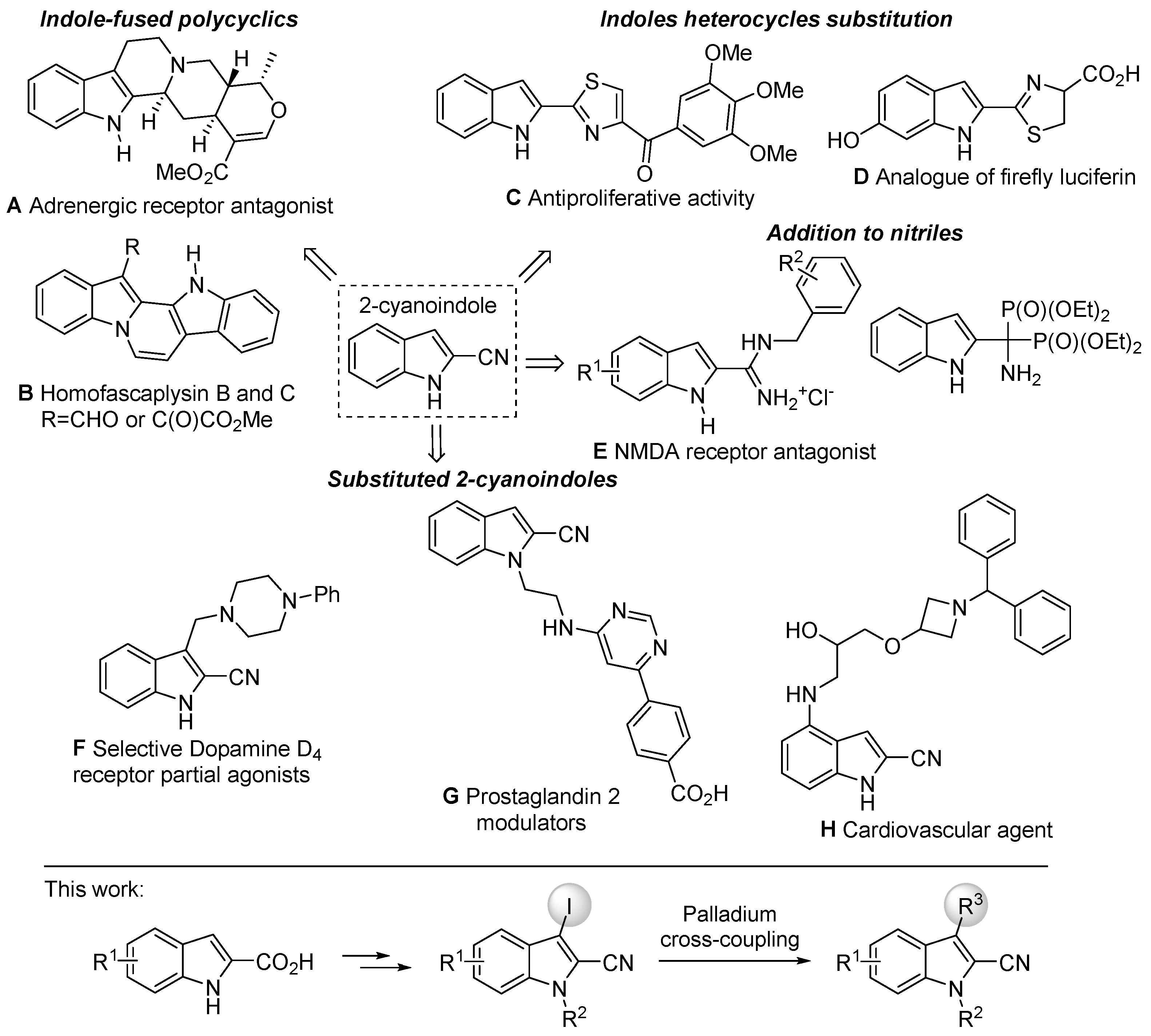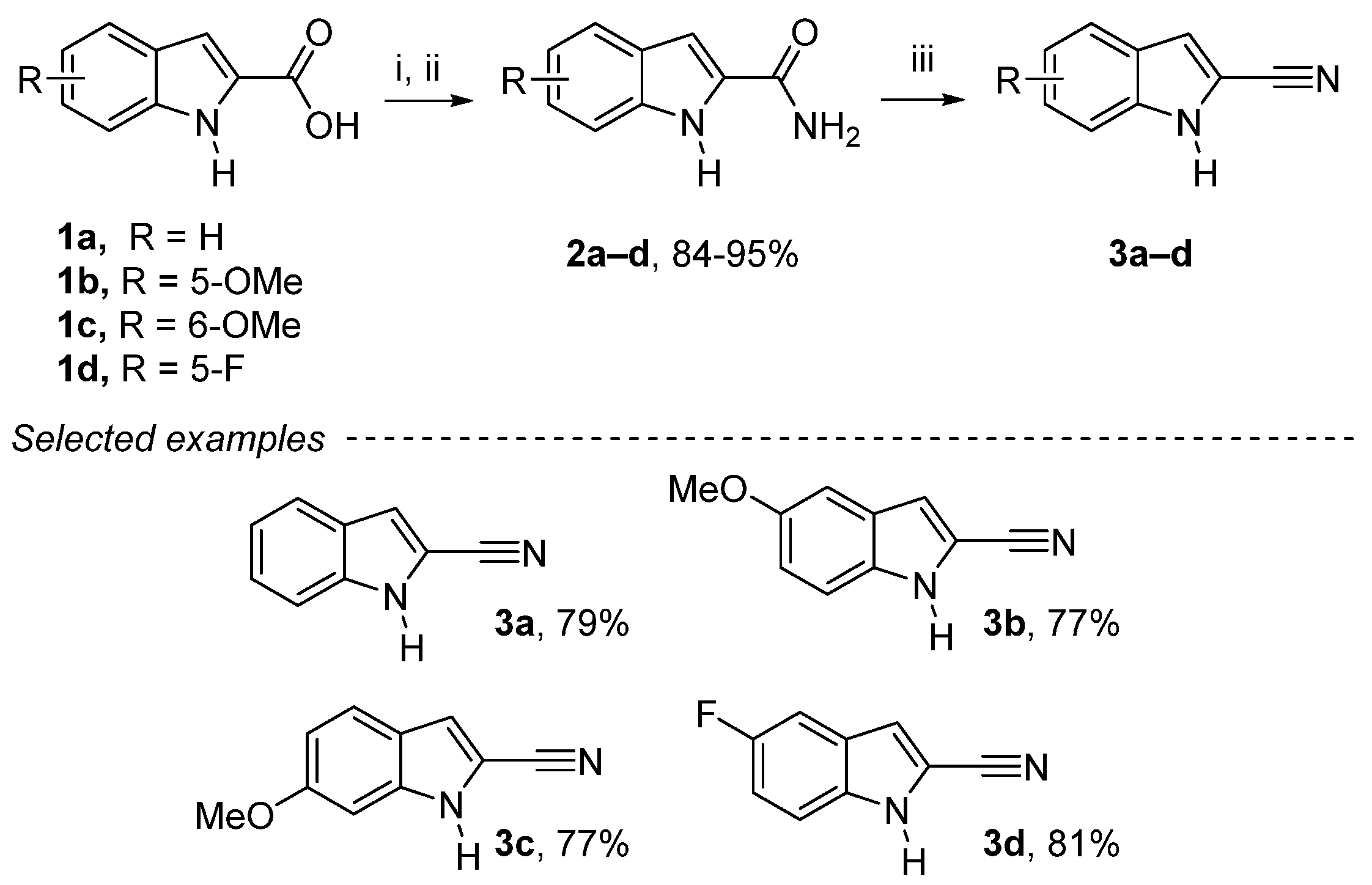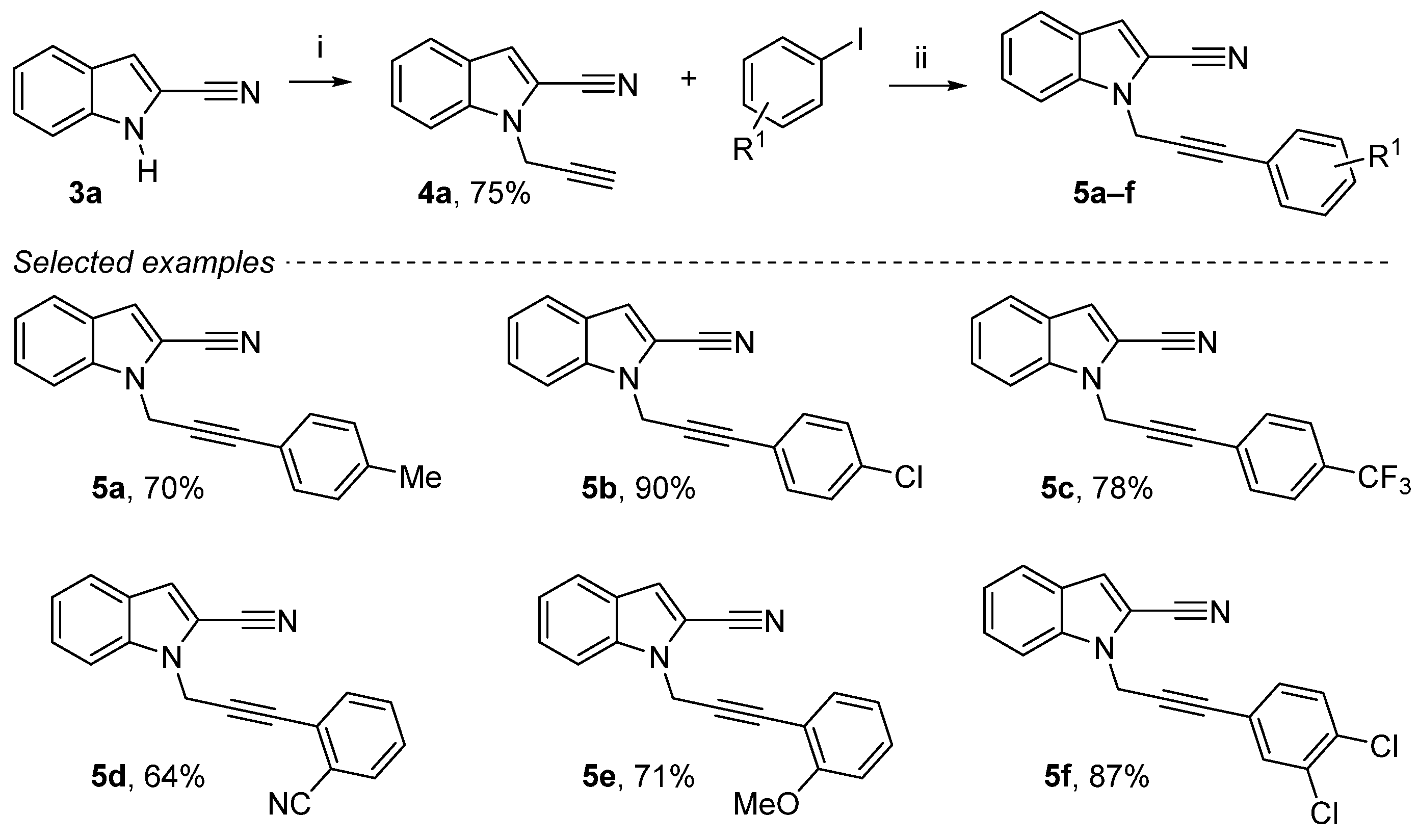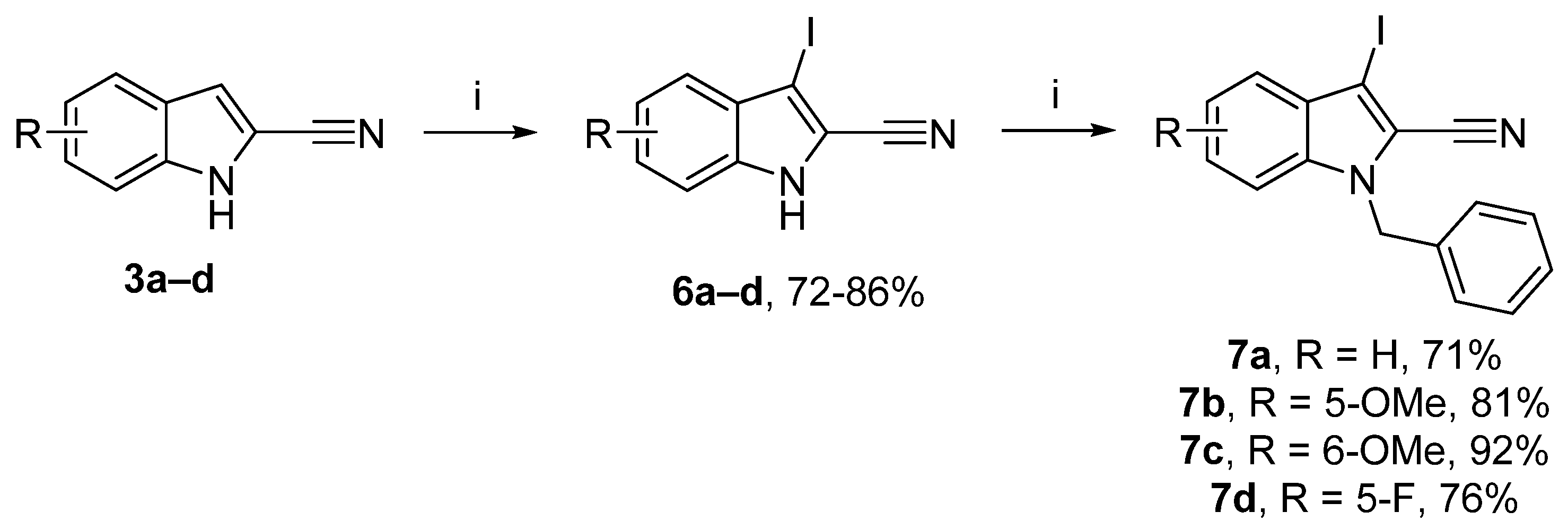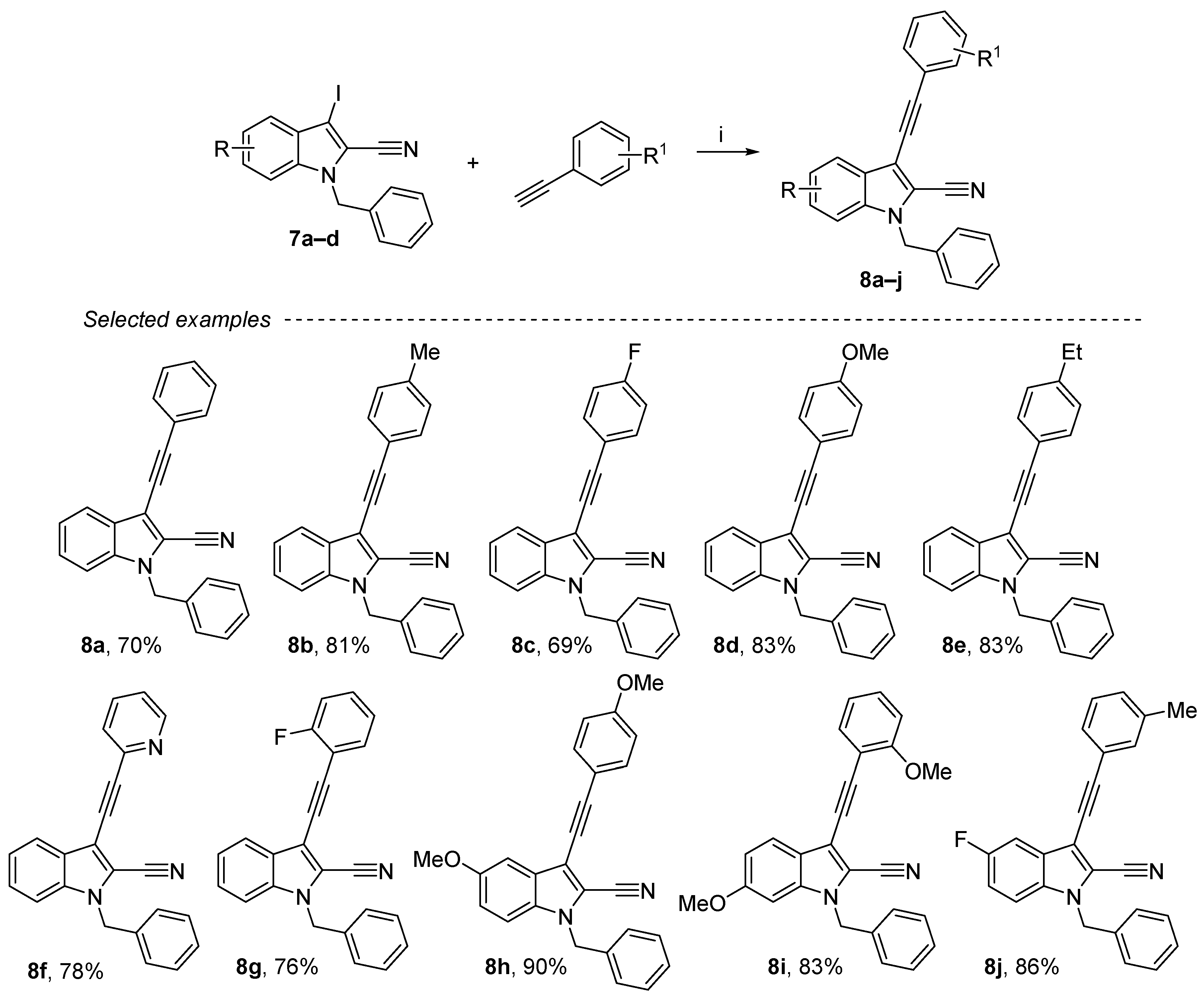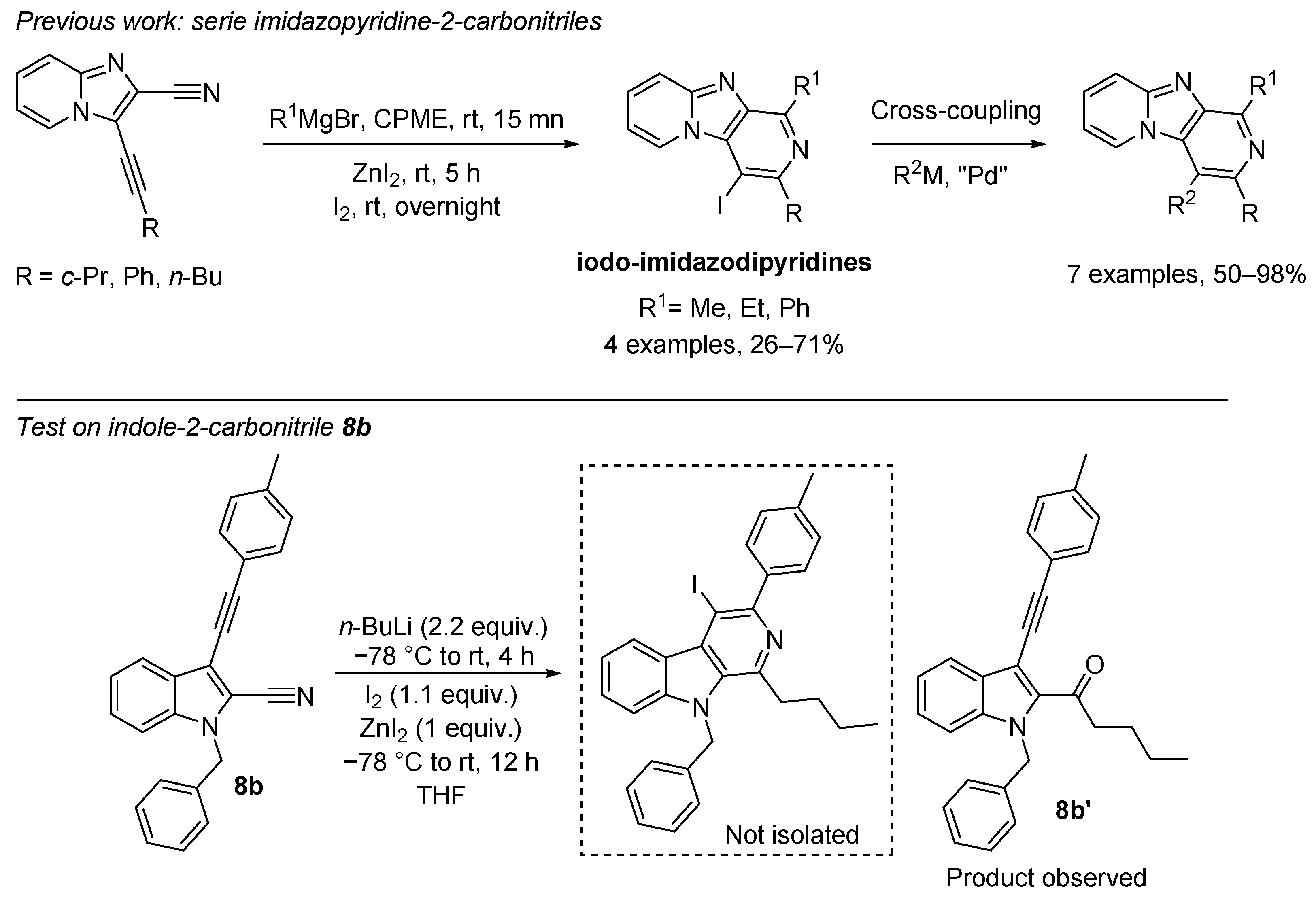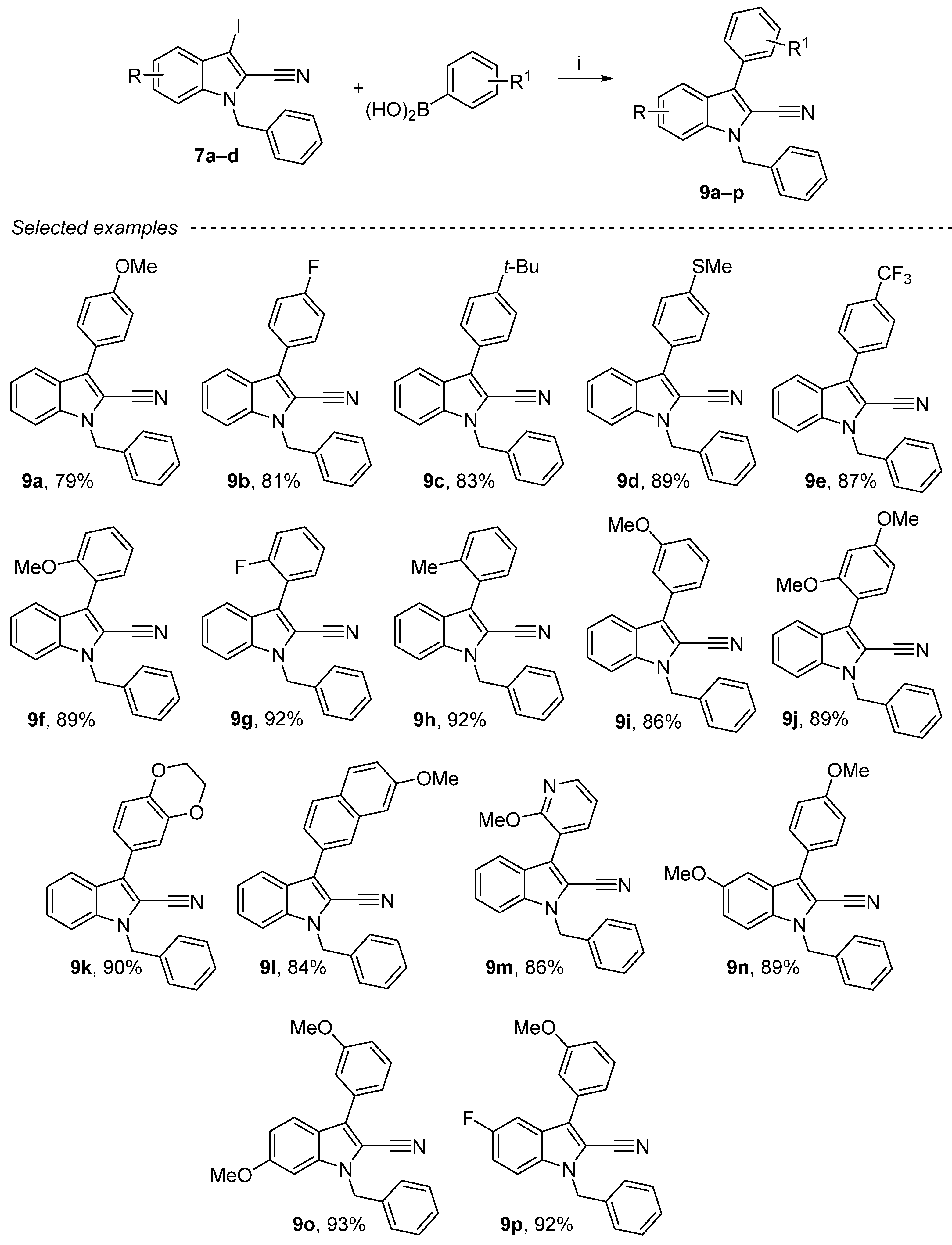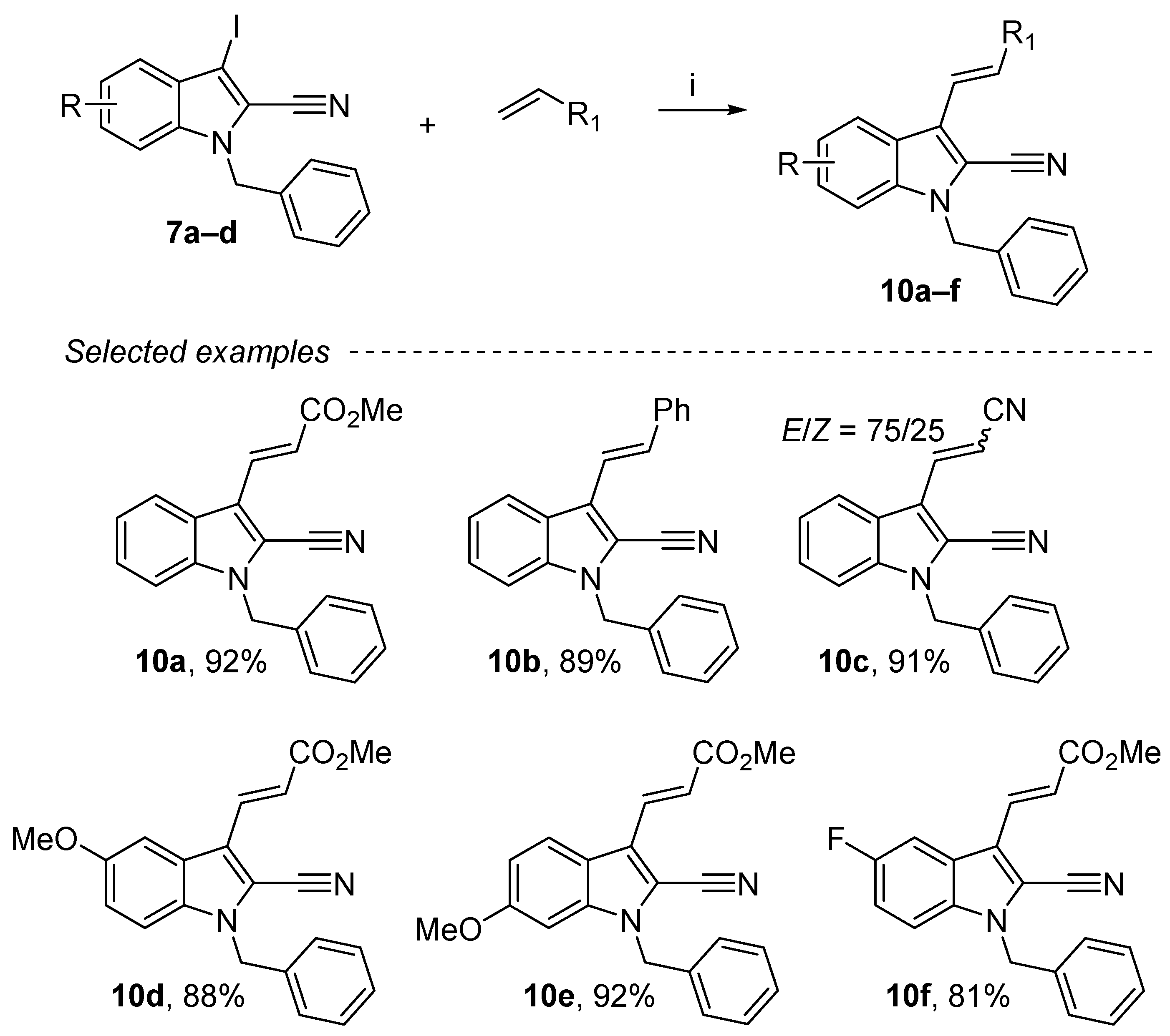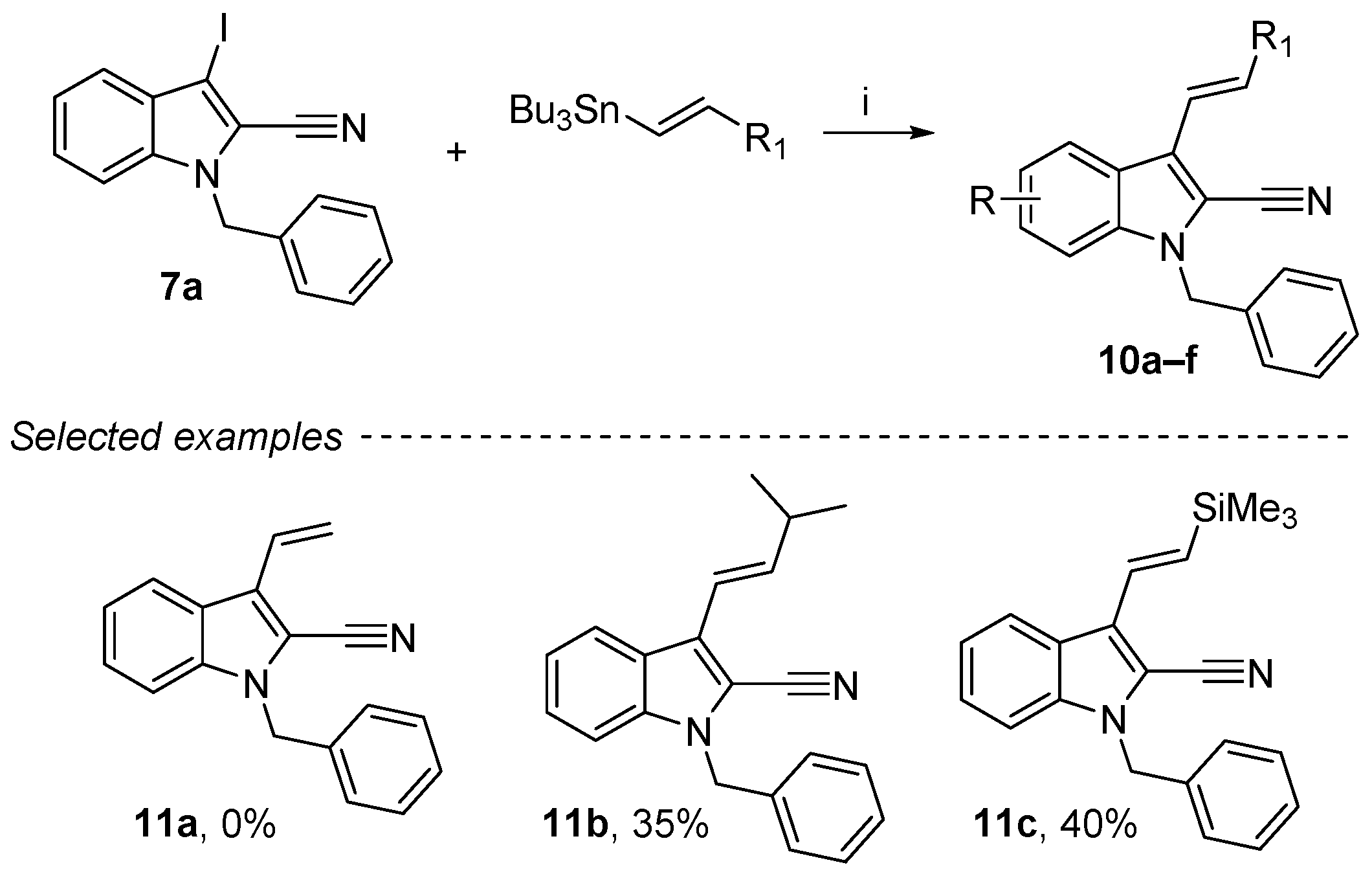3.2. Experimental Section
3.2.1. General Procedure for the Synthesis of Nitriles (Series 3)
To a solution of amide (4.0 g, 25.0 mmol, 1.0 equiv.) in chloroform (75 mL) was added dropwise phosphorus oxychloride (9.24 mL, 99.1 mmol, 4.0 equiv.). The mixture was stirred under reflux for 3 h and then cooled to room temperature. The reaction mixture was quenched by a 25% NH4OH aq. Solution (20 mL) and the resulting aqueous layer were extracted with Et2O (3 × 30 mL). The organic layers were combined, dried over MgSO4 and concentrated under reduced pressure. The crude product was purified by column chromatography using petroleum ether/ethyl acetate (80:20) as eluent.
1H-Indole-2-carbonitrile (
3a): Yellow solid, 79%, 2.83 g.
1H NMR (300 MHz, CDCl
3):
δ = 8.66 (bs, 1H, N
H), 7.68 (dq,
J = 8.1 Hz, 0.9 Hz, 1H, Ar-
H), 7.45–7.36 (m, 2H, Ar-
H), 7.25–7.19 (m, 2H, Ar-
H) ppm.
13C NMR (75 MHz, CDCl
3):
δ = 137.1 (C
quat), 126.3 (Ar-
CH), 126.2 (C
quat), 122.1 (Ar-
CH), 121.7 (Ar-
CH), 114.6 (C
quat), 114.5 (Ar-
CH), 112.0 (Ar-
CH), 106.0 (C
quat) ppm. These spectroscopic data correspond to the reported data in reference [
28].
5-Methoxy-1H-indole-2-carbonitrile (
3b): Yellow solid, 77%, 2.85 g.
1H NMR (300 MHz, CDCl
3):
δ = 8.57 (bs, 1H, N
H), 7.31 (dd,
J = 9.7 Hz,
J = 0.9 Hz, 1H, Ar-
H), 7.12 (dd,
J = 2.1 Hz,
J = 0.9 Hz, 1H, Ar-
H), 7.07 (d,
J = 2.4 Hz, 1H, Ar-H), 7.06–7.03 (m, 1H, Ar-
H), 6.83 (d,
J = 1.3 Hz, 1H, Ar-
H), 3.85 (s, 3H, OC
H3) ppm.
13C NMR (75 MHz, CDCl
3):
δ = 155.5 (C
quat), 132.3 (C
quat), 126.9 (C
quat), 118.1 (Ar-
CH), 114.4 (C
quat), 114.0 (Ar-
CH), 112.7 (Ar-
CH), 106.6 (C
quat), 102.1 (Ar-
CH), 55.8 (O
CH
3) ppm. These spectroscopic data correspond to the reported data in reference [
45].
6-Methoxy-1H-indole-2-carbonitrile (
3c): Yellow solid, 77%, 2.85 g.
1H NMR (300 MHz, CDCl
3):
δ = 8.71 (bs, 1H, N
H), 7.52 (d,
J = 8.8 Hz, 1H, Ar-
H), 7.13 (d,
J = 1.3 Hz, 1H, Ar-
H), 6.88 (dd,
J = 8,8 Hz, 2.1 Hz, 1H, Ar-
H), 6.83 (d,
J = 1.3 Hz, 1H, Ar-
H), 3.86 (s, 3H, OC
H3) ppm.
13C NMR (75 MHz, CDCl
3):
δ = 159.7 (C
quat), 138.2 (C
quat), 122.9 (Ar-
CH), 120.6 (C
quat), 114.9 (Ar-CH), 114.8 (C
quat), 113.4 (Ar-
CH), 104.8 (C
quat), 93.8 (
CH), 55.7 (O
CH
3) ppm. These spectroscopic data correspond to the reported data in reference [
27].
5-Fluoro-1H-indole-2-carbonitrile (
3d): Yellow solid, 81%, 2.90 g.
1H NMR (300 MHz, CDCl
3):
δ = 8.64 (bs, 1H, N
H), 7.37 (dd,
J = 9.0 Hz, 4.3 Hz, 1H, Ar-
H), 7.32 (dd,
J = 8.9 Hz, 2.5 Hz, 1H, Ar-
H), 7.20–7.12 (m, 2H, Ar-C
H) ppm.
13C NMR (75 MHz, CDCl
3):
δ = 158.7 (d,
J = 238.6 Hz, C
quat), 133.6 (C
quat), 126.6 (d,
J = 10.6 Hz, C
quat), 115.7 (d,
J = 27.1 Hz, Ar-
CH), 114.3 (d,
J = 5.4 Hz, Ar-
CH), 114.1 (C
quat), 113.0 (d,
J = 9.5 Hz, Ar-
CH), 107.7 (C
quat), 106.5 (d,
J = 23.8 Hz, Ar-
CH) ppm.
19F NMR (282 MHz, CDCl
3):
δ = −119.9 ppm. These spectroscopic data correspond to the reported data in reference [
45].
3.2.2. Typical Procedure for the Synthesis of Propargyl Compound 4
In a two-neck round bottom flask, NaH 60% (0.60 g,15.0 mmol, 1.3 equiv.) was dissolved in DMF (15 mL), and indole (7.03 mmol, 1 equiv.) in DMF (10 mL) was added dropwise at 0 °C under argon. The mixture was stirred for 30 min at room temperature. Propargyl bromide 80% (11.4 mmol, 1.3 equiv.) was diluted in DMF and added dropwise into the flask at 0 °C under argon. After 3–4 h of stirring at room temperature, the mixture was hydrolyzed with sat. aq. NH4Cl (10 mL), extracted with Et2O (7 × 20 mL), and the combined organic layers were washed with brine (6 × 10 mL), dried over MgSO4 and evaporated under reduced pressure.
1-(Prop-2-yn-1-yl)-1H-indole-2-carbonitrile (
4a): Yellow solid, 75%, 0.750 g.
1H NMR (300 MHz, CDCl
3):
δ = 7.69 (dt,
J = 8.1 Hz, 1H, Ar-
H), 7.51 (dd,
J = 8.4 Hz,
J = 0.9 Hz, 1H, Ar-
H), 7.48–7.41 (m, 1H, Ar-
H), 7.29–7.19 (m, 2H, Ar-
H), 5.04 (s, 2H, C
H2), 2.40 (t,
J = 2.5 Hz, 1H, C
H) ppm.
13C NMR (75 MHz, CDCl
3):
δ = 137.3 (C
quat), 126.6 (C
quat), 126.4 (Ar-
CH), 122.7 (Ar-
CH), 122.0 (Ar-
CH), 114.2 (Ar-
CH), 113.2 (C
quat), 110.7 (Ar-
CH), 109.6 (C
quat), 76.5 (C
quat), 74.2 (
CH), 34.4 (
CH
2) ppm. These spectroscopic data correspond to the reported data in reference [
10].
3.2.3. General Procedure for the Synthesis of Nitriles (Series 5)
A dried Schlenk tube was charged with compound 4a (1.6 mmol, 1 equiv.), aryl iodide derivative (2.1 mmol, 1.3 equiv.) and DMF (5 mL). The solution was cooled to 0 °C for 15 min under argon ant Et3N (4.8 mmol, 3 equiv.) was added into the Schlenk. CuI (0.16 mmol, 10 mol%) and PdCl2(PPh3)2 (0.16 mmol, 10 mol%) were added, and the mixture was stirred overnight at room temperature. The mixture was hydrolyzed with sat. aq. NH4Cl (10 mL) and extracted with Et2O (7 × 20 mL). The organic layers were washed with brine (2 × 10 mL), dried over MgSO4 and evaporated under reduced pressure.
1-(3-(p-Tolyl)prop-2-yn-1-yl)-1H-indole-2-carbonitrile (5a): Yellow solid, 70%, 252 mg. mp 96–98 °C. 1H NMR (300 MHz, CDCl3): δ = 7.69 (d, J = 8.1 Hz, 1H, Ar-H), 7.59 (dd, J = 8.5 Hz, 8.0 Hz, 1H, Ar-H), 7.45 (ddd, J = 8.4 Hz, J = 7.0 Hz, J = 1.1 Hz, 1H, Ar-H), 7.29 (d, J = 8.1 Hz, 2H), 7.27–7.21 (m, 2H), 7.09 (d, J = 7.9 Hz, 2H), 5.25 (s, 2H, CH2), 2.32 (s, 3H, CH3) ppm. 13C NMR (75 MHz, CDCl3): δ = 139.1 (Cquat), 137.3 (Cquat), 131.8 (2Ar-CH), 129.1 (2Ar-CH), 126.5 (Cquat), 126.2 (Ar-CH), 122.5 (Ar-CH), 121.8 (Ar-CH), 118.8 (Cquat), 113.9 (Ar-CH), 113.4 (Cquat), 110.8 (Ar-CH), 109.5 (Cquat), 85.9 (Cquat), 81.2 (Cquat), 35.7 (CH2), 21.5 (CH3) ppm. HRMS (ESI): calcd. for C19H15N2 (M + H)+ 271.12352; found 271.12347.
1-(3-(4-Chlorophenyl)prop-2-yn-1-yl)-1H-indole-2-carbonitrile (5b): Yellow solid, 90%, 353 mg). mp 98–100 °C. 1H NMR (300 MHz, CDCl3): δ = 7.69 (d, J = 8.1 Hz, 1H, Ar-H), 7.56 (d, J = 8.4 Hz, 1H, Ar-H), 7.46 (ddd, J = 8.1 Hz, J = 7.0 Hz, J = 1.0 Hz, 1H, Ar-H), 7.33 (d, J = 8.6 Hz, 2H, Ar-H), 7.30–7.22 (m, 4H, Ar-H), 5.25 (s, 2H, CH2) ppm. 13C NMR (75 MHz, CDCl3): δ = 137.3 (Cquat), 135.1 (Cquat), 133.2 (2Ar-CH), 128.8 (2Ar-CH), 126.6 (Cquat), 126.4 (Ar-CH), 122.7 (Ar-CH), 122.0 (Ar-CH), 120.4 (Cquat), 114.2 (Ar-CH), 113.3 (Cquat), 110.7 (Ar-CH), 109.6 (Cquat), 84.7 (Cquat), 82.9 (Cquat), 35.6 (CH2) ppm. HRMS (ESI): calcd. for C18H12ClN2 (M + H)+ 291.06890; found 291.06901.
1-(3-(4-(Trifluoromethyl)phenyl)prop-2-yn-1-yl)-1H-indole-2-carbonitrile (5c): Yellow solid, 78%, 341 mg. mp 110–112 °C. 1H NMR (300 MHz, CDCl3): δ = 7.71 (d, J = 8.1 Hz, 1H, Ar-H), 7.60–7.53 (m, 3H, Ar-H), 7.53–7.42 (m, 3H, Ar-H), 7.29 (m, 2H), 7.29 (dd, J = 7.1 Hz, J = 0.9 Hz, 1H, Ar-H), 7.24 (s, 1H, Ar-H), 5.28 (s, 2H, CH2) ppm. 13C NMR (75 MHz, CDCl3): δ = 137.4 (Cquat), 132.3 (2Ar-CH), 130.7 (q, J = 32.5 Hz, Cquat), 126.6 (Cquat), 125.7 (q, J = 1.3 Hz, Cquat), 125.4 (q, J = 3.7 Hz, 2Ar-CH), 123.9 (q, J = 272.8 Hz, Cquat), 122.7 (Ar-CH), 122.1 (Ar-CH), 114.3 (Ar-CH), 113.3 (Cquat), 110.6 (Ar-CH), 109.6 (Cquat), 84.4 (Cquat), 84.3 (Cquat), 35.6 (CH2) ppm. HRMS (ESI): calcd. for C19H12F3N2 (M + H)+ 325.09471; found 325.09395.
1-(3-(2-Cyanophenyl)prop-2-yn-1-yl)-1H-indole-2-carbonitrile (5d): Yellow solid, 64%, 379 mg. mp 137–139 °C. 1H NMR (300 MHz, CDCl3): δ = 7.71–7.62 (m, 2H, Ar-H), 7.54–7.47 (m, 3H, Ar-H), 7.46–7.39 (m, 2H, Ar-H), 7.29–7.22 (m, 2H, Ar-H), 5.34 (s, 2H, CH2) ppm. 13C NMR (75 MHz, CDCl3): δ = 137.4 (Cquat), 132.9 (Ar-CH), 132.7 (Ar-CH), 132.5 (Ar-CH), 129.2 (Ar-CH), 126.63 (Ar-CH), 126.6 (Cquat), 125.8 (Cquat), 122.6 (Ar-CH), 122.1 (Ar-CH), 117.3 (Cquat), 115.7 (Cquat), 114.4 (Ar-CH), 113.3 (Cquat), 111.0 (Ar-CH), 109.5 (Cquat), 88.3 (Cquat), 81.9 (Cquat), 35.6 (CH2) ppm. HRMS (ESI): calcd. for C19H11N3 (M + H)+ 282.10257; found 282.10179.
1-(3-(2-Methoxyphenyl)prop-2-yn-1-yl)-1H-indole-2-carbonitrile (5e): Yellow solid, 71%, 269 mg. mp 96–98 °C. 1H NMR (300 MHz, CDCl3): δ = 7.70–7.64 (m, 2H, Ar-H), 7.45 (ddd, J = 8.5 Hz, J = 7.1 Hz, J = 1.1 Hz, 1H, Ar-H), 7.35 (dd, J = 7.5 Hz, J = 1.6 Hz, 1H, Ar-H), 7.32–7.19 (m, 3H, 3Ar-H), 6.87 (td, J = 7.5 Hz, J = 0.9 Hz, 1H, Ar-H), 6.84 (d, J = 8.4 Hz, Ar-H), 5.29 (s, 2H, CH2), 3.84 (s, OCH3) ppm. 13C NMR (75 MHz, CDCl3): δ = 160.4 (Cquat), 137.4 (Cquat), 133.9 (Ar-CH), 130.4 (Ar-CH), 126.6 (Cquat), 126.1 (Ar-CH), 122.5 (Ar-CH), 121.8 (Ar-CH), 120.5 (Ar-CH), 113.9 (Ar-CH), 113.4 (Cquat), 111.2 (2Ar-CH + Cquat), 110.8 (Ar-CH), 109.6 (Cquat), 85.8 (Cquat), 82.4 (Cquat), 55.8 (OCH3), 36.1 (CH2) ppm. HRMS (ESI): calcd. for C19H15N2O (M + H)+ 287.11844; found 287.11835.
1-(3-(3,4-Dichlorophenyl)prop-2-yn-1-yl)-1H-indole-2-carbonitrile (5f): Yellow solid, 87%, 381 mg. mp 115–117 °C. 1H NMR (300 MHz, CDCl3): δ = 7.70 (d, J = 8.1 Hz, 1H, Ar-H), 7.54 (d, J = 8.4 Hz, 1H, Ar-H), 7.50–7.44 (m, 2H, Ar-H), 7.36 (d, J = 8.3 Hz, 1H, Ar-H), 7.27 (dd, J = 7.0 Hz, J = 1.0 Hz, 1H, Ar-H), 7.23 (s, 1H, Ar-H), 7.20 (dd, J = 8.4 Hz, J = 1.9 Hz, 1H, Ar-H), 5.25 (s, 2H, CH2) ppm. 13C NMR (75 MHz, CDCl3): δ = 137.3 (Cquat), 133.5 (Ar-CH), 132.7 (Cquat), 131.1 (Ar-CH), 130.5 (Ar-CH), 126.6 (Cquat), 126.5 (Ar-CH), 122.7 (Ar-CH), 122.1 (Ar-CH), 121.8 (Cquat), 114.3 (Ar-CH), 113.3 (Cquat), 111.8 (Cquat), 110.5 (Ar-CH), 109.6 (Cquat), 83.9 (Cquat), 83.5 (Cquat), 35.5 (CH2) ppm. HRMS (ESI): calcd. for C18H1035Cl2N2 (M + H)+ 325.02938; found 325.02841.
3.2.4. General Procedure for the Synthesis of Nitriles (Series 6)
To a solution of 1H-indole-2-carbonitrile (2.0 g, 14.1 mmol, 1.0 equiv.) in DMF (10 mL), KOH (0.79 g, 50.3 mmol, 3.6 equiv.) was added in small portions. The mixture was stirred for 30 min at room temperature. Then, a solution of iodine (3.57 g, 14.1 mmol, 1.0 equiv.) in DMF (3 mL) was added dropwise at 0 °C, and the mixture was stirred for 4 h at room temperature. The mixture was then poured into a mixture of water (600 mL) and sat. aq. NH4Cl (40 mL) and stirred for 30 min. The precipitate was filtered on a Büchner funnel and dried under vacuum for 2 h.
3-Iodo-1H-indole-2-carbonitrile (
6a): White solid, 77%, 2.90 g.
1H NMR (300 MHz, CDCl
3):
δ = 8.98 (bs, 1H, N
H), 7.49 (dq,
J = 8.1 Hz,
J = 0.9 Hz, 1H, Ar-
H), 7.47–7.39 (m, 2H, Ar-
H), 7.30 (ddd,
J = 8.1 Hz,
J = 6.2 Hz,
J = 1.8 Hz, 1H, Ar-
H) ppm.
13C NMR (75 MHz, DMSO-d
6):
δ = 137.0 (C
quat), 128.9 (C
quat), 126.6 (Ar-
CH), 122.0 (Ar-
CH), 121.8 (Ar-
CH), 114.3 (C
quat), 112.8 (Ar-
CH), 111.4 (C
quat), 72.0 (C
quat) ppm. These spectroscopic data correspond to the reported data in reference [
46].
3-Iodo-5-methoxy-1H-indole-2-carbonitrile (6b): White solid, 78%, 2.70 g. 1H NMR (300 MHz, DMSO-d6): δ = 12.74 (bs, 1H, NH), 7.40 (dd, J = 9.0 Hz, J = 0.4 Hz, 1H, Ar-H), 7.05 (dd, J = 9.0 Hz, 2.5 Hz, 1H, Ar-H), 6.77 (d, J = 2.3 Hz, 1H, Ar-H), 3.82 (s, 3H, OCH3) ppm. 13C NMR (75 MHz, DMSO-d6): δ = 155.4 (Cquat), 132.1 (Cquat), 129.3 (Cquat), 118.3 (Ar-CH), 114.4 (Cquat), 114.0 (Ar-CH), 111.2 (Cquat), 101.3 (Ar-CH), 70.8 (Cquat), 55.4 (OCH3) ppm. HRMS (ESI): calcd. for C10H8IN2O (M + H)+ 298.96813; found 298.96711.
3-Iodo-6-methoxy-1H-indole-2-carbonitrile (6c): White solid, 81%, 2.80 g. 1H NMR (300 MHz, CDCl3): δ = 9.09 (bs, 1H, NH), 7.31 (d, J = 9.2 Hz, 1H, Ar-H), 6.92 (dd, J = 9.2 Hz, 2.1 Hz, 1H, Ar-H), 6.80 (d, J = 2.1 Hz, 1H, Ar-H), 3.87 (s, 3H, OCH3) ppm. 13C NMR (75 MHz, CDCl3): δ = 160.6 (Cquat), 137.8 (Cquat), 124.0 (Cquat), 123.6 (Ar-CH), 114.4 (Ar-CH), 114.4 (Cquat), 110.4 (Cquat), 93.8 (Ar-CH), 72.5 (Cquat), 55.8 (OCH3) ppm. HRMS (ESI): calcd. for C10H8IN2O (M + H)+ 298.96813; found 298.96741.
5-Fluoro-3-iodo-1H-indole-2-carbonitrile (6d): White solid, 73%, 2.60 g. 1H NMR (300 MHz, DMSO-d6): δ = 12.05 (bs, 1H, NH), 8.03 (ddd, J = 9.0 Hz, 4.3 Hz, 0.4 Hz, 1H, Ar-H), 7.69 (td, J = 9.2 Hz, J = 2.5 Hz, 1H, Ar-H), 7.58 (ddd, J = 9.0 Hz, 2.5 Hz, 0.4 Hz, 1H, Ar-H) ppm. 13C NMR (75 MHz, Acetone-d6): δ = 159.9 (d, J =238.1 Hz, Cquat), 134.6 (Cquat), 130.6 (d, J = 10.7 Hz, Cquat), 116.6 (d, J = 27.2 Hz, Ar–CH), 115.3 (d, J = 9.5 Hz, Ar–CH), 114.7 (Cquat), 114.0 (Cquat), 107.1 (d, J = 24.9 Hz, Ar–CH), 70.1 (d, J = 5.6 Hz, Cquat) ppm. 19F NMR (282 MHz, CDCl3): δ = −119.6 Hz. HRMS (ESI): calcd. for C9H5FIN2 (M + H) + 286.94814; found 286.20350.
3.2.5. General Procedure for the Synthesis of Nitriles (Series 7)
To compound 6a (2.0 g, 7.4 mmol, 1 equiv.) in DMF (10 mL), NaH (0.17 g, 44 mmol, 1.2 equiv.) was added portion-wise at 0 °C under argon. The mixture was stirred for 30 min at room temperature. Then, benzyl bromide (0.57 mL, 0.0048 mol, 1.3 equiv.) was added dropwise at 0 °C. The mixture was stirred at room temperature for 3–4 h and hydrolyzed with sat. aq. NH4Cl (10 mL). The aqueous phase was extracted with DCM (3 × 20 mL), and the combined organic layers were dried over MgSO4 and concentrated under reduced pressure. The product was purified by column chromatography using petroleum ether/ethyl acetate (80:20) as eluent.
1-Benzyl-3-iodo-1H-indole-2-carbonitrile (7a): White solid, 71%, 1.90 g. mp 144–146 °C. 1H NMR (300 MHz, CDCl3): δ = 7.50 (dt, J = 8.1 Hz, 1.0 Hz, 1H, Ar-H), 7.41–7.38 (m, 1H, Ar-H), 7.37–7.27 (m, 5H, Ar-H), 7.18 (dd, J = 7.5 Hz, J = 2.0 Hz, 2H, Ar-H), 5.51 (s, 2H, CH2) ppm. 13C NMR (75 MHz, CDCl3): δ = 137.4 (Cquat), 135.6 (Cquat), 129.8 (Cquat), 129.2 (2Ar-CH), 128.5 (Ar-CH), 127.2 (Ar-CH), 127.0 (2Ar-CH), 123.2 (Ar-CH), 122.6 (Ar-CH), 115.4 (Cquat), 113.4 (Cquat), 111.1 (Ar-CH), 70.6 (Cquat), 50.1 (CH2) ppm. HRMS (ESI): calcd. for C16H12IN2 (M + H)+ 359.00397; found 359.00293.
1-Benzyl-3-iodo-5-methoxy-1H-indole-2-carbonitrile (7b): White solid, 81%, 2.10 g. 1H NMR (300 MHz, CDCl3): δ = 7.35–7.27 (m, 3H, Ar-H), 7.20 (d, J = 9.1 Hz, 1H, Ar-H), 7.15 (dd, J = 7.5 Hz, J = 2.4 Hz, 2H, Ar-H), 7.04 (dd, J = 9.1 Hz, J = 2.4 Hz, 1H, Ar-H), 6.82 (d, J = 2.4 Hz, 1H, Ar-H), 5.47 (s, 2H, CH2), 3.88 (s, 3H, OCH3) ppm. 13C NMR (75 MHz, CDCl3): δ = 156.3 (Cquat), 135.7 (Cquat), 132.7 (Cquat), 130.2 (Cquat), 129.2 (2Ar-CH), 128.4 (Ar-CH), 126.9 (2Ar-CH), 119.1 (Ar-CH), 115.3 (Cquat), 113.5 (Cquat), 112.2 (Ar-CH), 102.7 (Ar-CH), 69.4 (Cquat), 55.9 (OCH3), 50.2 (CH2) ppm. HRMS (ESI): calcd. for C17H14IN2O (M + H)+ 389.01453; found 389.01495.
1-Benzyl-3-iodo-6-methoxy-1H-indole-2-carbonitrile (7c): White solid, 92%, 2.40 g. 1H NMR (300 MHz, CDCl3): δ = 7.38–7.28 (m, 4H, Ar-H), 7.17 (dd, J = 7.6 Hz, J = 2.1 Hz, 2H, Ar-H), 6.92 (dd, J = 8.9 Hz, J = 2.1 Hz, 1H, Ar-H), 6.66 (d, J = 2.1 Hz, 1H, Ar-H), 5.43 (s, 2H, CH2), 3.81 (s, 3H, OCH3) ppm. 13C NMR (75 MHz, CDCl3): δ = 160.4 (Cquat), 138.5 (Cquat), 135.6 (Cquat), 129.2 (Ar-CH), 128.4 (Ar-CH), 127.0 (Ar-CH), 124.2 (Cquat), 124.0 (Ar-CH), 114.2 (Cquat), 113.9 (Ar-CH), 113.8 (Cquat), 92.9 (Ar-CH), 70.9 (Cquat), 55.8 (OCH3), 50.0 (CH2) ppm. HRMS (ESI): calcd. for C17H14IN2O (M + H)+ 389.01508; found 389.01492.
1-Benzyl-5-fluoro-3-iodo-1H-indole-2-carbonitrile (7d): White solid, 76%, 2.0 g. 1H NMR (300 MHz, CDCl3): δ = 7.37–7.27 (m, 4H, Ar-H), 7.26–7.23 (m, 1H, Ar-H), 7.19–7.11 (m, 3H, Ar-H), 5.49 (s, 2H, CH2) ppm. 13C NMR (75 MHz, CDCl3): δ = 159.3 (d, J = 241.0 Hz, Cquat), 135.3 (Cquat), 134.0 (Cquat), 130.3 (d, J = 10.6 Hz, Cquat), 129.3 (2Ar–CH), 128.6 (Ar–CH), 126.9 (2Ar–CH), 116.9 (Cquat), 116.5 (d, J = 27.1 Hz, Ar–CH), 113.0 (Cquat), 112.4 (d, J = 9.4 Hz, Ar–CH), 107.8 (d, J = 24.7 Hz, Ar–CH), 69.4 (d, J = 5.6 Hz, Cquat), 50.4 (CH2) ppm. 19F (282 MHz, CDCl3): δ = −119.9 ppm. HRMS (ESI): calcd. for C16H11FIN2 (M + H)+ 376.99509; found 376.99497.
3.2.6. General Procedure for Sonogashira Coupling (Series 8)
A Schlenk tube was charged with phenylacetylene (1.08 mmol, 1.3 equiv.), Et3N (0.34 mL, 2.52 mmol, 3.0 equiv.), DMF (3 mL), PdCl2(PPh3)2 (58 mg, 0.083 mmol, 10 mol%), compound 7a (300 mg, 0.837 mmol, 1 equiv.) and CuI (160 mg, 0.084 mmol, 10 mol%). The tube was evacuated and backfilled with argon, and the mixture was stirred at room temperature overnight. Then, the mixture was hydrolyzed with sat. aq. NH4Cl (10 mL), extracted by Et2O (3 × 20 mL), and the combined organic layers were washed with brine (6 × 10 mL), dried over MgSO4 and concentrated under reduced pressure. The product was purified by column chromatography using petroleum ether/ethyl acetate (80:20) as eluent.
1-Benzyl-3-(phenylethynyl)-1H-indole-2-carbonitrile (8a): Yellow solid, 70%, 195 mg. mp 125–127 °C. 1H NMR (300 MHz, CDCl3): δ = 7.88 (dt, J = 8.0 Hz, J = 1.0 Hz, 1H, Ar-H), 7.67–7.62 (m, 2H, Ar-H), 7.44–7.39 (m, 4H, Ar-H), 7.36–7.28 (m, 5H, Ar-H), 7.20 (dd, J = 7.6 Hz, 1.9 Hz, 2H, Ar-H), 5.48 (s, 2H, CH2) ppm. 13C NMR (75 MHz, CDCl3): δ = 137.1 (Cquat), 135.6 (Cquat), 131.9 (2Ar-CH), 129.2 (2Ar-CH), 128.8 (Ar-CH), 128.6 (2Ar-CH), 128.4 (Ar-CH), 127.5 (Cquat), 127.0 (Ar-CH), 127.0 (2Ar-CH), 123.0 (Cquat), 122.4 (Ar-CH), 121.8 (Ar-CH), 112.8 (2Cquat), 111.1 (Ar-CH), 109.8 (Cquat), 97.2 (Cquat), 79.6 (Cquat), 49.6 (CH2) ppm. HRMS (ESI): calcd. for C24H17N2 (M + H)+ 333.13863; found 333.13760.
1-Benzyl-3-(p-tolylethynyl)-1H-indole-2-carbonitrile (8b): Yellow solid, 81%, 235 mg. mp 163–165°C. 1H NMR (300 MHz, CDCl3): δ = 7.86 (d, J = 8.2 Hz, 1H, Ar-H), 7.51 (d, J = 8.1 Hz, 2H, Ar-H), 7.43–7.26 (m, 6H, Ar-H), 7.22–7.16 (m, 3H, Ar-H), 5.48 (s, 2H, CH2), 2.40 (s, 3H, CH3) ppm. 13C NMR (75 MHz, CDCl3): δ = 139.0 (Cquat), 137.1 (Cquat), 135.6 (Cquat), 131.7 (Ar-CH), 129.3 (Ar-CH), 129.1 (Ar-CH), 128.4 (Ar-CH), 127.5 (Cquat), 127.0 (Ar-CH), 122.3 (Ar-CH), 121.8 (Ar-CH), 119.9 (Cquat), 112.9 (Cquat), 112.6 (Cquat), 111.0 (Ar-CH), 110.1 (Cquat), 97.4 (Cquat), 79.0 (Cquat), 49.5 (CH2), 21.7 (CH3) ppm. HRMS (ESI): calcd. for C25H19N2 (M + H)+ 347.15482; found 346.15489.
1-Benzyl-3-((4-fluorophenyl)ethynyl)-1H-indole-2-carbonitrile (8c): Brown solid, 69%, 202 mg. mp 180–182 °C. 1H NMR (300 MHz, CDCl3): δ = 7.85 (dt, J = 8.0 Hz, J = 1.0 Hz, 1H, Ar-H), 7.60 (dd, J = 8.9 Hz, J = 5.4 Hz, 2H, Ar-H), 7.40 (ddd, J = 8.4 Hz, J = 6.6 Hz, J = 1.2 Hz, 1H, Ar-H), 7.35–7.27 (m, 5H, Ar-H), 7.21–7.18 (m, 2H, Ar-H), 7.08 (t, J = 8.7 Hz, 2H, Ar-H), 5.48 (s, 2H, CH2) ppm. 13C NMR (75 MHz, CDCl3): δ = 162.9 (d, J = 250.3 Hz, Cquat), 137.1 (Cquat), 135.6 (Cquat), 133.8 (d, J = 8.4 Hz, Ar-CH), 129.2 (2Ar–CH), 128.5 (Ar-CH), 127.5 (Cquat), 127.1 (Ar-CH), 127.0 (2Ar-CH), 122.4 (Ar-CH), 121.7 (Ar-CH), 119.1 (d, J = 3.5 Hz, Cquat), 115.9 (d, J = 22.1 Hz, Ar-CH), 112.9 (Cquat), 112.8 (Cquat), 111.1 (Ar-CH), 109.7 (Cquat), 96.0 (Cquat), 79.4 (Cquat), 49.6 (CH2) ppm. 19F NMR (282 MHz, CDCl3): δ = −110.2 ppm. HRMS (ESI): calcd. for C24H16FN2 (M-H)+ 351.12920; found 351.12816.
1-Benzyl-3-((4-methoxyphenyl)ethynyl)-1H-indole-2-carbonitrile (8d): Brown solid, 83%, 252 mg. mp 137–139 °C. 1H NMR (300 MHz, CDCl3): δ = 7.85 (dt, J = 8.0 Hz, J = 1.0 Hz, 1H, Ar-H), 7.56 (d, J = 8.9 Hz, 2H, Ar-H), 7.40 (ddd, J = 8.4 Hz, J = 6.7 Hz, J = 1.2 Hz, 1H, Ar-H), 7.36–7.24 (m, 6H, Ar-H), 7.19 (dd, J = 7.8 Hz, J = 2.0 Hz, 1H, Ar-H), 6.91 (d, J = 8.9 Hz, 2H, Ar-H), 5.47 (s, 2H, CH2), 3.85 (s, 3H, OCH3) ppm. 13C NMR (75 MHz, CDCl3): δ = 160.0 (Cquat), 137.0 (Cquat), 135.6 (Cquat), 133.3 (2Ar-CH), 129.1 (2Ar-CH), 128.3 (Ar-CH), 127.4 (Cquat), 126.9 (2Ar-CH), 122.2 (Ar-CH), 121.7 (Ar-CH), 115.0 (Cquat), 114.2 (Ar-CH), 112.9 (Cquat), 112.4 (Cquat), 111.0 (Ar-CH), 110.2 (Cquat), 97.2 (Cquat), 78.3 (Cquat), 55.4 (OCH3), 49.4 (CH2) ppm. HRMS (ESI): calcd. for C25H19N2O (M + H)+ 363.14919; found 363.14962.
1-Benzyl-3-((4-ethylphenyl)ethynyl)-1H-indole-2-carbonitrile (8e): Brown solid, 83%, 251 mg. mp 94–96 °C.1H NMR (300 MHz, CDCl3): δ = 7.86 (dt, J = 8.0 Hz, J = 1.0 Hz, 1H, Ar-H), 7.54 (d, J = 8.3 Hz, 2H, Ar-H), 7.40 (ddd, J = 8.4 Hz, J = 6.6 Hz, J = 1.2 Hz, 1H, Ar-H), 7.36–7.28 (m, 5H, Ar-H), 7.24–7.18 (m, 4H, Ar-H), 5.48 (s, 2H, CH2), 2.69 (q, J = 7.6 Hz, 2H, CH2), 1.26 (t, J = 7.6 Hz, 3H, CH3) ppm. 13C NMR (75 MHz, CDCl3): δ = 145.3 (Cquat), 137.0 (Cquat), 135.6 (Cquat), 131.8 (2Ar-CH), 129.1 (2Ar-CH), 128.4 (Ar-CH), 128.1 (2Ar-CH), 127.5 (Cquat), 127.0 (3Ar-CH), 122.3 (Ar-CH), 121.8 (Ar-CH), 120.1 (Cquat), 112.9 (Cquat), 112.6 (Cquat),111.0 (Ar-CH), 110.1 (Cquat), 97.4 (Cquat), 79.0 (Cquat), 49.5 (CH2), 29.0 (CH2), 15.5 (CH3) ppm. HRMS (ESI): calcd. for C26H21N2 (M + H)+ 361.16993; found 361.16903.
1-Benzyl-3-(pyridin-3-yl-ethynyl)-1H-indole-2-carbonitrile (8f): Brown solid, 78%, 216 mg. mp 138–140 °C. 1H NMR (300 MHz, CDCl3): δ = 8.67 (ddd, J = 4.9 Hz, J = 1.8 Hz, J = 1.0 Hz, 1H, Ar-H), 7.93 (dt, J = 8.1 Hz, J = 1.0 Hz, 1H, Ar-H), 7.72 (dt, J = 7.8 Hz, J = 1.8 Hz, 1H, Ar-H), 7.63 (dt, J = 7.8 Hz, J = 1.2 Hz, 1H, Ar-H), 7.41 (ddd, J = 8.4 Hz, J = 6.6 Hz, J = 1.2 Hz, 1H, Ar-H), 7.37–7.26 (m, 6H, Ar-H), 7.19 (dd, J = 7.7 Hz, J = 2.1 Hz, 2H, Ar-H), 5.50 (s, 2H, CH2) ppm. 13C NMR (75 MHz, CDCl3): δ = 150.1 (Ar-CH), 143.0 (Cquat), 136.9 (Cquat), 136.2 (Ar-CH), 135.3 (Cquat), 129.1 (2Ar-CH), 128.3 (Ar-CH), 127.6 (Ar-CH), 127.4 (Cquat), 127.0 (Ar-CH), 126.8 (2Ar-CH), 123.0 (Ar-CH), 122.5 (Ar-CH), 121.8 (Ar-CH), 113.5 (Cquat), 112.4 (Cquat), 111.0 (Ar-CH), 108.5 (Cquat), 95.9 (Cquat), 79.5 (Cquat), 49.5 (CH2) ppm. HRMS (ESI): calcd. for C23H16N3 (M + H)+ 334.13387; found 334.13301.
1-Benzyl-3-((2-fluorophenyl)ethynyl)-1H-indole-2-carbonitrile (8g): Brown solid, 76%, 222 mg. mp 178–180 °C. 1H NMR (300 MHz, CDCl3): δ = 7.88 (dt, J = 8.0 Hz, J = 0.9 Hz, 1H, Ar-H), 7.60 (td, J = 7.2 Hz, J = 1.9 Hz, 1H, Ar-H), 7.41 (ddd, J = 8.4 Hz, J = 6.7 Hz, J = 1.2 Hz, 1H, Ar-H), 7.38–7.27 (m, 6H, Ar-H), 7.21–7.11 (m, 4H, Ar-H), 5.50 (s, 2H, CH2) ppm. 13C NMR (75 MHz, CDCl3): δ = 162.7 (d, J = 252.3 Hz, Cquat), 137.0 (Cquat), 135.5 (Cquat), 133.5 (Ar-CH), 130.5 (d, J = 7.9 Hz, Ar-CH), 129.1 (2Ar-CH), 128.4 (Ar-CH), 127.5 (Cquat), 127.1 (Ar-CH), 127.0 (2Ar-CH), 124.1 (d, J = 3.7 Hz, Ar-CH), 122.6 (Ar-CH), 121.8 (Ar-CH), 115.7 (d, J = 20.7 Hz, Ar-CH), 112.8 (Cquat), 112.7 (Cquat), 111.6 (d, J = 15.7 Hz, Cquat), 111.1 (Ar-CH), 109.3 (Cquat), 90.4 (Cquat), 84.7 (Cquat), 49.5 (CH2) ppm. 19F NMR (282 MHz, CDCl3): δ = −112.1 ppm. HRMS (ESI): calcd. for C24H16FN2 (M + H)+ 351.12920; found 351.12956.
1-Benzyl-5-methoxy-3-((4-methoxyphenyl)ethynyl)-1H-indole-2-carbonitrile (8h): Brown solid, 90%, 272 mg. 1H NMR (300 MHz, CDCl3): δ = 7.57 (d, J = 8.9 Hz, 2H, Ar-H), 7.35–7.28 (m, 3H, Ar-H), 7.20 (d, J = 9.1 Hz, 1H, Ar-H), 7.16 (dd, J = 7.4 Hz, J = 2.4 Hz, 2H, Ar-H), 7.04 (dd, J = 9.1 Hz, J 2.5 Hz, 1H, Ar-H), 6.91 (d, J = 8.9 Hz, 2H, Ar-H), 5.44 (s, 2H, CH2), 3.89 (s, 3H, OCH3), 3.85 (s, 3H, OCH3) ppm. 13C NMR (75 MHz, CDCl3): δ = 160.0 (Cquat), 156.1 (Cquat), 135.7 (Cquat), 133.4 (2Ar-CH), 132.4 (Cquat), 129.1 (2Ar-CH), 128.4 (Ar-CH), 128.1 (Cquat), 126.9 (2Ar-CH), 118.6 (Ar-CH), 115.1 (Cquat), 114.2 (2Ar-CH), 113.0 (Cquat), 112.6 (Cquat), 112.1 (Ar-CH), 109.3 (Cquat), 101.6 (Ar-CH), 97.0 (Cquat), 78.4 (Cquat), 55.9 (OCH3), 55.5 (OCH3), 49.7 (CH2) ppm. HRMS (ESI): calcd. for C26H21N2O2 (M + H)+ 393.15975; found 393.16029.
1-Benzyl-6-methoxy-3-((2-methoxyphenyl)ethynyl)-1H-indole-2-carbonitrile (8i): Brown solid, 83%, 252 mg. 1H NMR (300 MHz, CDCl3): δ = 7.74 (d, J = 8.8 Hz, 1H, Ar-H), 7.56 (dd, J = 7.6 Hz, J = 1.6 Hz, 1H, Ar-H), 7.39–7.28 (m, 4H, Ar-H), 7.17 (dd, J = 7.6 Hz, J = 1.6 Hz, 2H, Ar-H), 6.98 (dd, J = 7.6 Hz, J = 1.0 Hz, 1H, Ar-H), 6.96–6.90 (m, 2H, Ar-H), 6.67 (d, J = 2.1 Hz, 1H, Ar-H), 5.41 (s, 2H, CH2), 3.96 (s, 3H, OCH3), 3.80 (s, 3H, OCH3) ppm. 13C NMR (75 MHz, CDCl3): δ = 160.3 (Cquat), 160.1 (Cquat), 138.2 (Cquat), 135.7 (Cquat), 133.5 (Ar-CH), 130.2 (Ar-CH), 129.1 (2Ar-CH), 128.3 (Ar-CH), 126.9 (2Ar-CH), 122.7 (Ar-CH), 121.8 (Cquat), 120.6 (Ar-CH), 113.4 (Ar-CH), 113.2 (Cquat), 112.4 (Cquat), 111.4 (Cquat), 111.0 (Ar-CH), 110.5 (Cquat), 93.5 (Cquat), 93.2 (Ar-CH), 83.8 (Cquat), 56.0 (OCH3), 55.7 (OCH3), 49.4 (CH2) ppm. HRMS (ESI): calcd. for C26H21N2O2 (M + H)+ 393.15975; found 393.15951.
1-Benzyl-5-fluoro-3-(m-tolylethynyl)-1H-indole-2-carbonitrile (8j): Brown solid, 86%, 250 mg. 1H NMR (300 MHz, CDCl3): δ = 7.55–7.46 (m, 3H), 7.38–7.27 (m, 4H), 7.25–7.08 (m, 5H), 5.46 (s, 2H), 2.40 (s, 3H) ppm. 13C NMR (75 MHz, CDCl3): δ = 159.2 (d, J = 241.2 Hz, Cquat), 139.2 (Cquat), 135.4 (Cquat), 133.7 (Cquat), 131.8 (2Ar-CH), 129.4 (2Ar-CH), 129.3 (2Ar-CH), 128.6 (Ar-CH), 128.1 (d, J = 10.4 Hz, Cquat), 126.9 (2Ar-CH), 119.7 (Cquat), 116.2 (d, J = 27.0 Hz, Ar-CH), 114.0 (Cquat), 112.5 (Cquat), 112.3 (d, J = 9.1 Hz, Ar-CH), 109.8 (d, J = 5.4 Hz, Cquat), 106.5 (d, J = 24.0 Hz), 97.8 (Cquat), 78.4 (Cquat), 49.9 (CH2), 21.7 (CH3) ppm. 19F NMR (282 MHz, CDCl3): δ = −120.3 ppm. HRMS (ESI): calcd. for C25H18FN2 (M + H)+ 365.14540; found 365.14514.
3.2.7. General Procedure for Suzuki Coupling (Series 9)
A Schlenk tube was charged with toluene (3 mL), ethanol (2 mL), sat. aq. NaHCO3 (1.5 mL), compound 7a (300 mg, 0.83 mmol, 1 equiv.) and boronic acid (1.2 mmol, 1.5 equiv.). The tube was vigorously stirred for few minutes and Pd(PPh3)4 (90 mg, 0.083 mmol, 10 mol%) was added to the solution. The mixture was heated at 130 °C for 4 h and then cooled to room temperature. The mixture was extracted with EtOAc (3 × 10 mL), and the combined organic layers were washed with water (2 × 10 mL) and dried over MgSO4. Solvents were removed under reduced pressure, and the residue was purified by column chromatography using petroleum ether/EtOAc as eluent (80:20).
1-Benzyl-3-(4-methoxyphenyl)-1H-indole-2-carbonitrile (9a): Brown solid, 79%, 221 mg. mp 153–155 °C. 1H NMR (300 MHz, CDCl3): δ = 7.85 (dt, J = 8.2 Hz, J = 0.9 Hz, 1H, Ar-H), 7.67 (d, J = 8.9 Hz, 2H, Ar-H), 7.39–7.35 (m, 2H, Ar-H), 7.33–7.28 (m, 3H, Ar-H), 7.26–7.20 (m, 3H, Ar-H), 7.07 (d, J = 8.9 Hz, 2H, Ar-H), 5.52 (s, 2H, CH2), 3.89 (s, 3H, OCH3) ppm. 13C NMR (75 MHz, CDCl3): δ = 159.7 (Cquat), 138.0 (Cquat), 136.2 (Cquat), 130.1 (2Ar-CH), 129.1 (2Ar-CH), 128.5 (Cquat), 128.2 (2Ar-CH), 127.1 (2Ar-CH), 126.5 (Ar-CH), 125.3 (Cquat), 124.4 (Cquat), 121.8 (2Ar-CH), 114.7 (2Ar-CH), 114.5 (Cquat), 110.9 (Ar-CH), 107.2 (Cquat), 55.5 (OCH3), 49.2 (CH2) ppm. HRMS (ESI): calcd. for C23H19N2O (M + H)+ 339.14919; found 339.14965.
1-Benzyl-3-(4-fluorophenyl)-1H-indole-2-carbonitrile (9b): Brown solid, 81%, 220 mg. mp 120–122 °C. 1H NMR (300 MHz, CDCl3): δ = 7.82 (dt, J = 8.2 Hz, J = 0.9 Hz, 1H, Ar-H), 7.70 (dd, J = 8.8 Hz, J = 5.3 Hz, 2H, Ar-H), 7.42–7.39 (m, 2H, Ar-H), 7.37–7.27 (m, 3H, Ar-H), 7.25–7.19 (m, 3H, Ar-H), 5.53 (s, 2H, CH2) ppm. 13C NMR (75 MHz, CDCl3): δ = 162.6 (d, J = 248.0 Hz, Cquat), 137.9 (Cquat), 136.0 (Cquat), 130.6 (d, J = 8.1 Hz, Ar-CH), 129.1 (2Ar-CH), 128.3 (Ar-CH), 127.9 (d, J = 3.3 Hz, Cquat), 127.5 (Cquat), 127.0 (2Ar-CH), 126.6 (Ar-CH), 125.1 (Cquat), 122.1 (Ar-CH), 121.4 (Ar-CH), 116.2 (d, J = 21.6 Hz, Ar-CH), 114.1 (Cquat), 111.0 (Ar-CH), 107.5 (Cquat), 49.2 (CH2) ppm. 19F NMR (282 MHz, CDCl3): δ = −113.2 ppm. HRMS (ESI): calcd. for C22H16FN2 (M + H)+ 327.12975; found 327.12988.
1-Benzyl-3-(4-(tert-butyl)phenyl)-1H-indole-2-carbonitrile (9c): Brown solid, 83%, 252 mg. mp 149–151 °C. 1H NMR (300 MHz, CDCl3): δ = 7.92 (dt, J = 8.2 Hz, J = 0.8 Hz, 1H, Ar-H), 7.72 (d, J = 8.5 Hz, 2H, Ar-H), 7.57 (d, J = 8.5 Hz, 2H, Ar-H), 7.40–7.37 (m, 2H, Ar-H), 7.35–7.207 (m, 6H, Ar-H), 5.51 (s, 2H, CH2), 1.41 (s, 9H, C(CH3)3) ppm. 13C NMR (75 MHz, CDCl3): δ = 151.2 (Cquat), 138.0 (Cquat), 136.2 (Cquat), 129.1 (2Ar-CH), 129.0 (Cquat), 128.6 (Cquat), 128.5 (2Ar-CH), 128.2 (Ar-CH), 127.0 (2Ar-CH), 126.5 (Ar-CH), 126.1 (2Ar-CH), 125.0 (Cquat), 121.9 (Ar-CH), 121.8 (Ar-CH), 114.5 (Cquat), 111.0 (Ar-CH), 107.4 (Cquat), 49.1 (CH2), 34.8 (Cquat), 31.4 (C(CH3)3) ppm. HRMS (ESI): calcd. for C26H25N2 (M + H)+ 365.20177; found 365.20152.
1-Benzyl-3-(4-(methylthio)phenyl)-1H-indole-2-carbonitrile (9d): Yellow viscous liquid, 89%, 263 mg. 1H NMR (300 MHz, CDCl3): δ = 7.85 (dd, J = 8.2 Hz, J = 0.9 Hz, 1H, Ar-H), 7.67 (d, J = 8.6 Hz, 2H, Ar-H), 7.42–7.38 (m, 4H, Ar-H), 7.36–7.29 (m, 3H, Ar-H), 7.26–7.22 (m, 3H, Ar-H), 5.53 (s, 2H, CH2), 2.55 (s, 3H, CH3) ppm. 13C NMR (75 MHz, CDCl3): δ = 138.8 (Cquat), 138.0 (Cquat), 136.1 (Cquat), 129.2 (2Ar-CH), 129.1 (2Ar-CH), 128.6 (Cquat), 128.3 (Ar-CH), 128.1 (Cquat), 127.1 (4Ar-CH), 126.6 (Ar-CH), 126.6 (Ar-CH), 125.1 (Cquat), 122.0 (Ar-CH), 121.7 (Ar-CH), 114.3 (Cquat), 111.0 (Ar-CH), 107.4 (Cquat), 49.2 (CH2), 15.8 (CH3) ppm. HRMS (ESI): calcd. for C23H19N2S (M + H)+ 355.12635; found 355.12680.
1-Benzyl-3-(4-(trifluoromethyl)phenyl)-1H-indole-2-carbonitrile (9e): Brown liquid, 87%, 272 g. 1H NMR (300 MHz, CDCl3): δ = 7.86 (d, J = 8.5 Hz, 2H, Ar-H), 7.85 (dd, J = 8.2 Hz, J = 0.9 Hz, 1H, Ar-H), 7.79 (d, J = 8.5 Hz, 2H, Ar-H), 7.45–7.42 (m, 2H, Ar-H), 7.38–7.28 (m, 4H, Ar-H), 7.27–7.22 (m, 2H, Ar-H), 5.55 (s, 2H, CH2) ppm. 13C NMR (75 MHz, CDCl3): δ = 137.9 (Cquat), 135.8 (Cquat), 135.7 (q, J = 1.2 Hz, Cquat), 130.0 (q, J = 32.7 Hz, Cquat), 129.2 (2Ar-CH), 129.1 (2Ar-CH), 128.4 (Ar-CH), 127.1 (2Ar-CH), 126.9 (Ar-CH), 126.7 (Cquat), 126.1 (q, J = 3.8 Hz, 2Ar-CH), 124.9 (Cquat), 124.2 (q, J = 272.2 Hz, Cquat), 122.5 (Ar-CH), 121.3 (Ar-CH), 113.8 (Cquat), 111.2 (Ar-CH), 108.1 (Cquat), 49.3 (CH2) ppm. 19F NMR (282 MHz, CDCl3): δ = −62.5 ppm. HRMS (ESI): calcd. for C23H16F3N2 (M + H)+ 377.12656; found 377.12516.
1-Benzyl-3-(2-methoxyphenyl)-1H-indole-2-carbonitrile (9f): Brown solid, 89%, 250 mg. mp 132–134 °C. 1H NMR (300 MHz, CDCl3): δ = 7.91 (dd, J = 8.2 Hz, J = 0.9 Hz, 1H, Ar-H), 7.52–7.40 (m, 4H, Ar-H), 7.37–7.27 (m, 5H, Ar-H), 7.25–7.23 (m, 2H, Ar-H), 6.99 (ddd, J = 8.2 Hz, J = 2.6 Hz, J = 1.0 Hz, 1H, Ar-H), 5.54 (s, 2H, CH2), 3.90 (s, 3H, OCH3) ppm. 13C NMR (75 MHz, CDCl3): δ = 160.2 (Cquat), 138.0 (Cquat), 136.1 (Cquat), 133.2 (Cquat), 130.2 (Ar-CH), 129.1 (2Ar-CH), 128.4 (Cquat), 128.3 (Ar-CH), 127.0 (2Ar-CH), 126.6 (Ar-CH), 125.2 (Cquat), 122.0 (Ar-CH), 121.8 (Ar-CH), 121.3 (Ar-CH), 114.2 (Ar-CH), 114.1 (Ar-CH), 111.0 (Ar-CH), 109.1 (Cquat), 107.7 (Cquat), 55.5 (CH2), 49.2 (OCH3) ppm. HRMS (ESI): calcd. for C23H19N2O (M + H)+ 339.14919; found 339.14959.
1-Benzyl-3-(2-fluorophenyl)-1H-indole-2-carbonitrile (9g): White solid, 92%, 250 mg. mp 151–153 °C. 1H NMR (300 MHz, CDCl3): δ = 7.69 (ddt, J = 8.2 Hz, J = 2.2 Hz, J = 1.0 Hz, 1H, Ar-H), 7.62 (m, 1H, Ar-H), 7.48–7.39 (m, 4H, Ar-H), 7.37–7.29 (m, 4H, Ar-H), 7.28–7.21 (m, 3H, Ar-H), 5.55 (s, 2H, CH2) ppm. 13C NMR (75 MHz, CDCl3): δ = 159.9 (d, J = 249.1 Hz, Cquat), 137.6 (Cquat), 136.0 (Cquat), 131.7 (d, J = 3.1 Hz, Ar-CH), 130.2 (d, J = 8.2 Hz, Ar-CH), 129.1 (2Ar-CH), 128.3 (Ar-CH), 127.1 (2Ar-CH), 126.5 (Ar-CH), 125.7 (Cquat), 124.7 (d, J = 3.6 Hz, Ar-CH), 122.0 (d, J = 3.2 Hz, Ar-CH), 122.0 (Ar-CH), 119.6 (d, J = 15.4 Hz, Cquat), 116.5 (d, J = 22.1 Hz, Ar-CH), 113.6 (Cquat), 111.9 (Ar-CH), 109.1 (Cquat), 104.5 (Cquat), 49.4 (CH2) ppm. 19F NMR (282 MHz, CDCl3): δ = −112.1 ppm. HRMS (ESI): calcd. for C22H16FN2 (M + H)+ 327.12975; found 327.13012.
1-Benzyl-3-(o-tolyl)-1H-indole-2-carbonitrile (9h): Brown solid, 92%, 246 mg. mp 130–132 °C. 1H NMR (300 MHz, CDCl3): δ = 7.49 (dt, J = 8.1 Hz, J = 1.0 Hz, 1H, Ar-H), 7.42–7.37 (m, 5H, Ar-H), 7.36–7.32 (m, 4H, Ar-H), 7.27–7.18 (m, 3H, Ar-H), 5.55 (s, 2H, CH2), 2.31 (s, 3H, CH3) ppm. 13C NMR (75 MHz, CDCl3): δ = 137.5 (Cquat), 137.3 (Cquat), 136.2 (Cquat), 131.0 (Ar-CH), 130.9 (Cquat), 130.7 (Ar-CH), 129.1 (2Ar-CH), 128.7 (Cquat), 128.6 (Ar-CH), 128.2 (Ar-CH), 127.0 (2Ar-CH), 126.4 (Ar-CH), 126.3 (Cquat), 126.0 (Ar-CH), 122.0 (Ar-CH), 121.6 (Ar-CH), 113.8 (Cquat), 110.9 (Ar-CH), 108.9 (Cquat), 49.2 (CH2), 20.3 (CH3) ppm. HRMS (ESI): calcd. for C23H19N2 (M + H)+ 323.15428; found 323.15463.
1-Benzyl-3-(3-methoxyphenyl)-1H-indole-2-carbonitrile (9i): Solid orange, 86%, 241 mg. mp 131–133 °C. 1H NMR (300 MHz, CDCl3): δ = 7.91 (d, J = 8.2 Hz, 1H, Ar-H), 7.46 (t, J = 7.9 Hz, 1H, Ar-H), 7.41–7.39 (m, 2H, Ar-H), 7.37–7.27 (m, 5H, Ar-H), 7.25–7.23 (m, 2H, Ar-H), 6.99 (ddd, J = 8.2 Hz, J = 2.5 Hz, J = 0.8 Hz, 1H, Ar-H), 5.54 (s, 2H, CH2), 3.90 (s, 3H, OCH3) ppm. 13C NMR (75 MHz, CDCl3): δ = 160.2 (Cquat), 138.0 (Cquat), 136.1 (Cquat), 133.2 (Cquat), 130.2 (Ar-CH), 129.1 (2Ar-CH), 128.4 (Cquat), 128.3 (Ar-CH), 127.1 (2Ar-CH), 126.6 (Ar-CH), 125.2 (Cquat), 122.0 (Ar-CH), 121.8 (Ar-CH), 121.3 (Ar-CH), 114.2 (Cquat), 114.2 (Ar-CH), 114.1 (Ar-CH), 111.0 (Ar-CH), 107.7 (Cquat), 55.5 (CH3), 49.2 (CH2) ppm. HRMS (ESI): calcd. for C23H19N2O (M + H)+ 339.14919; found 339.14965.
1-Benzyl-3-(2,4-dimethoxyphenyl)-1H-indole-2-carbonitrile (9j): Brown liquid, 89%, 248 mg. 1H NMR (300 MHz, CDCl3): δ = 7.64 (dt, J = 8.1 Hz, J = 0.9 Hz, 2H, Ar-H), 7.42 (d, J = 8.8 Hz, 1H, Ar-H), 7.34–7.27 (m, 5H, Ar-H), 7.24–7.14 (m, 3H, Ar-H), 6.63 (s, 1H, Ar-H), 6.62 (dd, J = 7.6 Hz, J = 2.4 Hz, 1H, Ar-H), 5.49 (s, 2H, CH2), 3.87 (s, 3H, OCH3), 3.84 (s, 3H, OCH3) ppm. 13C NMR (75 MHz, CDCl3): δ = 161.3 (Cquat), 158.1 (Cquat), 137.6 (Cquat), 136.4 (Cquat), 132.2 (Ar-CH), 129.0 (2Ar-CH), 128.1 (Ar-CH), 127.1 (2Ar-CH), 126.2 (Cquat), 126.0 (Ar-CH), 124.7 (Cquat), 122.4 (Ar-CH), 121.3 (Ar-CH), 114.3 (Cquat), 113.3 (Cquat), 110.7 (Ar-CH), 109.1 (Cquat), 104.9 (Ar-CH), 99.2 (Ar-CH), 55.6 (OCH3), 55.4 (OCH3), 49.2 (CH2) ppm. HRMS (ESI): calcd. for C24H21N2O2 (M + H)+ 369.16030; found 369.16135.
1-Benzyl-3-(2,3-dihydrobenzo[b][
1,
4]
dioxin-6-yl)-1H-indole-2-carbonitrile (
9k): Brown solid, 90%, 273 mg. mp 140–142 °C.
1H NMR (300 MHz, CDCl
3):
δ = 7.87 (d,
J = 8.2 Hz, 2H, Ar-
H), 7.38–7.36 (m, 2H, Ar-
H), 7.35–7.27 (m, 4H, Ar-
H), 7.25–7.21 (m, 4H, Ar-
H), 7.02 (d,
J = 8.3 Hz, 2H, Ar-
H), 5.51 (s, 2H, C
H2), 4.32 (s, 4H, 2 x C
H2) ppm.
13C NMR (75 MHz, CDCl
3):
δ = 144.0 (C
quat), 143.7 (C
quat), 137.8 (C
quat), 136.1 (C
quat), 129.0 (2Ar-
CH), 128.1 (Ar-
CH), 128.1 (C
quat), 127.0 (2Ar-
CH), 126.4 (Ar-
CH), 125.1 (2C
quat), 122.0 (Ar-
CH), 121.8 (Ar-
CH), 121.7 (Ar-
CH), 118.0 (Ar-
CH), 117.6 (Ar-
CH), 114.3 (C
quat), 110.8 (Ar-
CH), 107.2 (C
quat), 64.5 (
CH
2), 64.4 (
CH
2), 49.0 (
CH
2) ppm. HRMS (ESI): calcd. for C
24H
19N
2O
2 (M + H)
+ 367.14465; found 367.14425.
1-Benzyl-3-(6-methoxynaphthalen-2-yl)-1H-indole-2-carbonitrile (9l): Brown solid, 84%, 272 mg. mp 147–149 °C. 1H NMR (300 MHz, CDCl3): δ = 8.13 (s, 1H, Ar-H), 7.96–7.81 (m, 4H, Ar-H), 7.41–7.19 (m, 10H, Ar-H), 5.52 (s, 2H, CH2), 3.94 (s, 3H, OCH3) ppm. 13C NMR (75 MHz, CDCl3): δ = 158.3 (Cquat), 138.0 (Cquat), 136.2 (Cquat), 134.3 (Cquat), 129.8 (Ar-CH), 129.2 (Cquat), 129.1 (2Ar-CH), 128.7 (Cquat), 128.2 (Ar-CH), 127.8 (Ar-CH), 127.7 (Ar-CH), 127.2 (Ar-CH), 127.1 (Cquat), 127.0 (2Ar-CH), 126.6 (Ar-CH), 125.4 (Cquat), 121.9 (Ar-CH), 121.8 (Ar-CH), 119.5 (Ar-CH), 114.4 (Cquat), 111.0 (Ar-CH), 107.6 (Cquat), 105.8 (Ar-CH), 55.5 (OCH3), 49.2 (CH2) ppm. HRMS (ESI): calcd. for C27H21N2O (M + H)+ 389.16484; found 389.16527.
1-Benzyl-3-(2-methoxypyridin-3-yl)-1H-indole-2-carbonitrile (9m): Brown liquid, 86%, 241 mg. 1H NMR (300 MHz, CDCl3): δ = 8.27 (dd, J = 5.0 Hz, J = 1.9 Hz, 1H, Ar-H), 7.83 (dd, J = 7.3 Hz, J = 1.9 Hz, 1H, Ar-H), 7.63 (d, J = 8.2 Hz, 2H, Ar-H), 7.39–7.37 (m, 3H, Ar-H), 7.34–7.29 (m, 3H, Ar-H), 7.27–7.19 (m, 2H, Ar-H), 7.05 (dd, J = 7.3 Hz, J = 5.1 Hz, 1H, Ar-H), 5.54 (s, 2H, CH2), 4.03 (s, 3H, OCH3) ppm. 13C NMR (75 MHz, CDCl3): δ = 161.3 (Cquat), 147.0 (Ar-CH), 139.9 (Ar-CH), 137.6 (Cquat), 136.1 (Cquat), 129.1 (2Ar-CH), 128.3 (Ar-CH), 127.1 (2Ar-CH), 126.4 (Ar-CH), 125.8 (Cquat), 122.8 (Cquat), 122.1 (Ar-CH), 121.8 (Ar-CH), 117.0 (Ar-CH), 115.3 (Cquat), 113.7 (Cquat), 111.0 (Ar-CH), 109.4 (Cquat), 53.6 (CH2), 49.4 (OCH3) ppm. HRMS (ESI): calcd. for C22H18N3O (M + H)+ 340.14499; found 340.14471.
1-Benzyl-5-methoxy-3-(4-methoxyphenyl)-1H-indole-2-carbonitrile (9n): Brown solid, 89%, 254 mg. mp 152–154 °C. 1H NMR (300 MHz, CDCl3): δ = 7.65 (d, J = 8.8 Hz, 2H, Ar-H), 7.37–7.27 (m, 3H, Ar-H), 7.26–7.18 (m, 4H, Ar-H), 7.10–7.02 (m, 3H, Ar-H), 5.48 (s, 2H, CH2), 3.89 (s, 3H, OCH3), 3.82 (s, 3H, OCH3) ppm. 13C NMR (75 MHz, CDCl3): δ = 159.5 (Cquat), 155.7 (Cquat), 136.3 (Cquat), 133.3 (Cquat), 129.9 (2Ar-CH), 129.1 (2Ar-CH), 128.2 (Ar-CH), 127.6 (Cquat), 127.0 (2Ar-CH), 125.6 (Cquat), 124.5 (Cquat), 118.0 (Ar-CH), 114.7 (2Ar-CH), 114.5 (Cquat), 111.9 (Ar-CH), 107.5 (Cquat), 101.6 (Ar-CH), 55.9 (OCH3), 55.5 (OCH3), 49.3 (CH2) ppm. HRMS (ESI): calcd. for C24H21N2O2 (M + H)+ 369.15975; found 369.16033.
1-Benzyl-6-methoxy-3-(3-methoxyphenyl)-1H-indole-2-carbonitrile (9o): Brown solid, 93%, 264 mg. mp 150–152 °C. 1H NMR (300 MHz, CDCl3): δ = 7.78 (d, J = 8.9 Hz, 1H, Ar-H), 7.46 (t, J = 7.9 Hz, 1H, Ar-H), 7.41–7.22 (m, 7H, Ar-H), 6.99 (dd, J = 7.9 Hz, J = 2.1 Hz, 1H, Ar-H), 6.93 (dd, J = 8.9 Hz, J = 2.1 Hz, 1H, Ar-H), 6.75 (d, J = 2.1 Hz, 1H, Ar-H), 5.49 (s, 2H, CH2), 3.91 (s, 3H, OCH3), 3.84 (s, 3H, OCH3) ppm. 13C NMR (75 MHz, CDCl3): δ = 160.2 (Cquat), 159.8 (Cquat), 139.1 (Cquat), 136.1 (Cquat), 133.3 (Cquat), 130.2 (Ar-CH), 129.1 (2Ar-CH), 128.8 (Cquat), 128.2 (Ar-CH), 127.0 (2Ar-CH), 122.6 (Ar-CH), 121.2 (Ar-CH), 119.5 (Cquat), 114.6 (Cquat), 114.2 (Ar-CH), 114.0 (Ar-CH), 113.1 (Ar-CH), 106.4 (Cquat), 93.1 (Ar-CH), 55.7 (OCH3), 55.5 (OCH3), 49.1 (CH2) ppm. HRMS (ESI): calcd. for C24H21N2O2 (M + H)+ 369.15975; found 369.16017.
1-Benzyl-5-fluoro-3-(3-methoxyphenyl)-1H-indole-2-carbonitrile (9p): Yellow viscous liquid, 98%, 279 mg. 1H NMR (300 MHz, CDCl3): δ = 7.51 (dd, J = 7.4 Hz, J = 1.6 Hz, 1H), 7.44 (td, J = 8.1 Hz, J = 1.7 Hz, 1H), 7.36–7.23 (m, 1H), 7.16–7.08 (m, 3H), 5.52 (s, 2H), 3.90 (s, 3H) ppm. 13C NMR (75 MHz, CDCl3): δ = 158.7 (d, J = 238.7 Hz, Cquat), 156.9 (Cquat), 136.0 (Cquat), 134.1 (Cquat), 131.4 (Ar-CH), 130.0 (Ar-CH), 129.1 (2Ar-CH), 128.3 (Ar-CH), 127.0 (2Ar-CH), 126.4 (d, J = 10.5 Hz, Cquat), 124.2 (d, J = 5.5 Hz, Cquat), 121.0 (Ar-CH), 120.1 (Cquat), 115.2 (d, J = 26.8 Hz, Ar-CH), 113.7 (Cquat), 111.8, (d, J = 9.4 Hz, Ar-CH), 111.5 (Ar-CH), 110.8 (Cquat), 106.8 (d, J = 24.1 Hz, Ar-CH), 55.4 (OCH3), 49.5 (CH2) ppm. 19F NMR (282 MHz, CDCl3): δ = −121.7 ppm. HRMS (ESI): calcd. for C23H18FN2O (M + H)+ 357.14032; found 357.14081.
3.2.8. General Procedure for Heck Coupling (Series 10)
Compound 7a (300 mg, 0.083 mmol, 1 equiv.), alkene (1.2 mmol, 1.5 equiv), KOAc (50 mg, 0.5 mmol, 6 equiv.), Pd(OAc)2 (0.74 mg, 0.003 mmol, 0.04 equiv.), tBuNH4Cl(46 mg, 0.166 mmol, 2 equiv.) and DMF (5 mL) were introduced in a sealed tube. The tube was vacuumed and backfilled with argon. The reaction mixture was stirred at 80 °C for 24 h and then cooled to room temperature. The reaction mixture was quenched with water, filtered through a Celite© pad and washed with EtOAc (100 mL). Then, the resulting organic layer was washed with sat. aq. NH4Cl (2 × 40 mL) and brine (3 × 40 mL). The organic layers were dried over MgSO4 and concentrated under reduced pressure. The crude product was purified by column chromatography using petroleum ether/EtOAc as eluent (70:30).
(E)-Methyl-3-(1-benzyl-2-cyano-1H-indol-3-yl) acrylate (10a): Brown solid, 92%, 244 mg. 1H NMR (300 MHz, CDCl3): δ = 7.99 (d, J = 16.2 Hz, 1H, CH=CH), 7.95 (dt, J = 8.2 Hz, J = 0.9 Hz, 1H, Ar-H), 7.46–7.30 (m, 6H, Ar-H), 7.18 (m, 2H, Ar-H), 6.76 (d, J = 16.2 Hz, 1H, CH=CH), 5.50 (s, 2H, CH2), 3.85 (s, 3H, OCH3) ppm. 13C NMR (75 MHz, CDCl3): δ = 167.5 (Cquat), 138.1 (Cquat), 135.3 (Cquat), 134.0 (CH=CH), 129.2 (2Ar-CH), 128.5 (Ar-CH), 127.1 (Ar-CH), 127.0 (2Ar-CH), 124.9 (Cquat), 123.2 (Ar-CH), 121.8 (Cquat), 121.6 (Ar-CH), 119.1 (CH=CH), 112.8 (Cquat), 111.7 (Cquat), 111.5 (Ar-CH), 52.0 (OCH3), 49.6 (CH2) ppm. HRMS (ESI): calcd. for C20H17N2O2 (M + H)+ 317.12900; found 317.12946.
(E)-1-Benzyl-3-styryl-1H-indole-2-carbonitrile (10b): Brown solid, 89%, 257 mg. 1H NMR (300 MHz, CDCl3): δ = 8.06 (dt, J = 8.1 Hz, J = 0.7 Hz, 1H), 7.66–7.58 (m, 2H, Ar-H), 7.51 (d, J = 16.5 Hz, CH=CH), 7.45–7.29 (m, 10H, 9Ar-H + CH=CH), 7.23–7.20 (m, 2H, Ar-H), 5.45 (s, 2H, CH2) ppm. 13C NMR (75 MHz, CDCl3): δ = 138.1 (Cquat), 137.3 (Cquat), 135.9 (Cquat), 131.2 (CH=CH), 129.1 (2Ar-CH), 128.9 (2ArCH), 128.2 (Ar-CH), 128.1 (Ar-CH), 126.9 (2Ar-CH), 126.6 (Ar-CH), 126.5 (2Ar-CH), 125.2 (Cquat), 124.6 (Cquat), 122.0 (CH=CH), 121.7 (Ar-CH), 118.4 (Ar-CH), 113.9 (Cquat), 111.0 (Ar-CH), 108.6 (Cquat), 49.1 (CH2) ppm. HRMS (ESI): calcd. for C24H19N2 (M + H)+ 335.15482; found 335.15532.
1-Benzyl-3-(3-cyanoprop-1-en-1-yl)-1H-indole-2-carbonitrile (10c): Brown solid, 81%, 192 mg. 1H NMR (300 MHz, CDCl3): δ = 8.09 (d, J = 8.1 Hz, 1H, Z-isomer), 7.79 (d, J = 8.2 Hz, 1H, E-isomer), 7.61 (d, J = 16.7 Hz, 1H, E-isomer), 7.52–7.29 (m, Ar-CH), 7.23–7.18 (m, Ar-CH), 6.14 (d, J = 16.7 Hz, 1H, E-isomer), 5.64 (d, J = 12.1 Hz, 1H, Z-isomer), 5.48 (s, 2H) ppm. 13C NMR E-isomer (75 MHz, CDCl3): δ = 139.5 (CH=CH), 137.9 (Cquat), 134.9 (Cquat), 129.2 (2Ar-CH), 128.6 (Ar-CH), 127.4 (Ar-CH), 126.9 (2Ar-CH), 124.1 (Cquat), 123.7 (Ar-CH), 120.8 (Ar-CH), 120.7 (Cquat), 118.3 (Cquat), 111.2 (Cquat), 111.7 (Ar-CH), 111.3 (Cquat), 96.9 (CH=CH), 49.6 (CH2) ppm. HRMS (ESI): calcd. for C19H14N3 (M + H)+ 284.11877; found 284.11842.
(E)-Methyl-3-(1-benzyl-2-cyano-5-methoxy-1H-indol-3-yl) acrylate (10d): Brown solid, 88%, 236 mg. 1H NMR (300 MHz, CDCl3): δ = 7.97 (d, J = 16.2 Hz, 1H, CH=CH), 7.36–7.28 (m, 3H, Ar-CH), 7.27–7.23 (m, 2H, Ar-CH), 7.16 (dd, J = 7.5 Hz, J = 2.0 Hz, 2H, Ar-CH), 7.06 (dd, J = 9.2 Hz, J = 2.3 Hz, 1H, Ar-CH), 6.69 (d, J = 16.2 Hz, 1H, CH=CH) 5.46 (s, 2H, CH2), 3.88 (s, 3H, OCH3), 3.85 (s, 3H, OCH3) ppm. 13C NMR (75 MHz, CDCl3): δ = 167.6 (Cquat), 156.6 (Cquat), 135.3 (Cquat), 134.1 (CH=CH), 133.2 (Cquat), 129.2 (2Ar-CH), 128.5 (Ar-CH), 126.9 (2Ar-CH), 125.5 (Cquat), 120.8 (Cquat), 118.4 (Ar-CH), 118.1 (Ar-CH), 112.9 (Cquat), 112.4 (Ar-CH), 111.3 (Cquat), 101.6 (Ar-CH), 55.9 (OCH3), 51.9 (OCH3), 49.7 (CH2) ppm. HRMS (ESI): calcd. for C21H19N2O3 (M + H)+ 347.13957; found 347.14053.
(E)-Methyl-3-(1-benzyl-2-cyano-6-methoxy-1H-indol-3-yl) acrylate (10e): Brown solid, 92%, 247 mg. 1H NMR (300 MHz, CDCl3): δ = 7.90 (d, J = 16.1 Hz, 1H, CH=CH), 7.76 (d, J = 9.0 Hz, 1H, Ar-CH), 7.35–7.28 (m, 3H, Ar-CH), 7.21–7.13 (m, 2H, Ar-CH),6.94 (dd, J = 8.9 Hz, J = 2.0 Hz, 1H, Ar-CH), 6.71 (s, 1H, Ar-CH), 6.68 (d, J = 16.1 Hz, 1H, CH=CH), 5.40 (s, 2H, CH2), 3.83 (s, 3H, OCH3), 3.80 (s, 3H, OCH3) ppm. 13C NMR (75 MHz, CDCl3): δ = 167.4 (Cquat), 159.9 (Cquat), 139.3 (Cquat), 135.2 (Cquat), 134.6 (Cquat), 133.9 (CH=CH), 129.2 (2Ar-CH), 128.4 (Ar-CH), 126.9 (2Ar-CH), 122.2 (Ar-CH), 122.0 (Cquat), 118.8 (Ar-CH), 113.9 (Ar-CH), 113.0 (Cquat), 110.4 (Cquat), 93.6 (CH=CH), 55.6 (OCH3), 51.8 (OCH3), 49.3 (CH2) ppm. HRMS (ESI): calcd. for C21H19N2O3 (M + H)+ 347.13957; found 347.14046.
(E)-Methyl-3-(1-benzyl-2-cyano-5-fluoro-1H-indol-3-yl)acrylate (10f): Brown solid, 81%, 215 mg. 1H NMR (300 MHz, CDCl3): δ = 7.92 (d, J = 16.2 Hz, 1H, CH=CH), 7.57 (dd, J = 9.1 Hz, J = 2.4 Hz, 1H, Ar-CH), 7.40–7.27 (m, 4H, Ar-CH), 7.22–7.12 (m, 3H, Ar-CH), 6.67 (d, J = 16.2 Hz, 1H, CH=CH), 5.48 (s, 2H, CH2), 3.85 (s, 3H, OCH3) ppm. 13C NMR (75 MHz, CDCl3): δ = 167.3 (Cquat), 159.6 (d, J = 241.4 Hz, Cquat), 134.6 (Cquat), 133.5 (CH=CH), 129.3 (2Ar-CH), 128.7 (Ar-CH), 126.9 (2Ar-CH), 125.2 (d, J = 10.1 Hz, Cquat), 121.4 (d, J = 5.3 Hz, Cquat), 119.2 (CH=CH), 116.2 (d, J = 26.8 Hz, Ar-CH), 112.9 (Cquat), 112.7 (d, J = 9.6 Hz, Ar-CH), 112.4 (Cquat), 106.5 (d, J = 24.5 Hz, Ar-CH), 52.0 (OCH3), 49.9 (CH2) ppm. 19F NMR (282 MHz, CDCl3): δ = −118.71 ppm. HRMS (ESI): calcd. for C20H16FN2O2 (M + H)+ 335.11958; found 335.12021.
3.2.9. General Procedure for Stille Coupling (Series 11)
A Schlenk flask was charged with compound 7a (300 mg, 0.84 mmol, 1 equiv.), DMF (5 mL), vinyl tin derivatives (1.008 mmol, 1.2 equiv.) and PdCl2(MeCN)2 (21.8 mg, 0.084 mmol, 10 mol%) under argon. The mixture was stirred at 40 °C for 1 week. Then, the reaction mixture was added to a mixture of KF (2 M) and ethyl acetate (50:50), stirred for 30 min at room temperature and filtered through a Celite© pad. Solvents were removed under reduced pressure, and the crude product was purified by column chromatography with a stationary phase composed of 10% powdered anhydrous K2CO3 and silica, using petroleum ether/ethyl acetate as eluent (99.9:0.1).
(E)-1-Benzyl-3-(3-methylbut-1-en-1-yl)-1H-indole-2-carbonitrile (11b): Brown oil, 35%, 88 mg. 1H NMR (300 MHz, CDCl3): δ = 7.90 (dt, J = 8.2 Hz, J = 0.9 Hz, Hz, 1H), 7.39–7.26 (m, 5H, Ar-CH), 7.25–7.13 (m, 3H, Ar-CH), 6.63 (d, J = 16.2 Hz, 1H, CH=CH), 6.54 (dd, J = 16.2 Hz, J = 6.2 Hz, 1H, CH=CH), 5.44 (s, 2H, CH2), 2.56 (oct, J = 6.6 Hz, 1H, CH(CH3)2), 1.16 (d, J = 6.7 Hz, 6H, 2xCH3) ppm. 13C NMR (75 MHz, CDCl3): δ = 141.8 (CH=CH), 138.1 (Cquat), 136.2 (Cquat), 129.1 (2Ar-CH), 128.2 (Ar-CH), 127.0 (Cquat), 126.9 (2Ar-CH), 126.5 (Ar-CH), 125.8 (Cquat), 124.8 (Cquat), 121.8 (Ar-CH), 121.6 (CH=CH), 116.9 (Ar-CH), 114.1 (Cquat), 110.9 (Ar-CH), 49.0 (CH2), 32.5 (CH(CH3)2), 22.6 (2xCH3) ppm. HRMS (ESI): calcd. for C21H21N2 (M + H)+ 301.17047; found 301.17038.
(E)-1-Benzyl-3-(2-(trimethylsilyl)vinyl)-1H-indole-2-carbonitrile (11c): Orange oil, 40%, 111 mg. 1H NMR (300 MHz, CDCl3): δ = 8.01 (dt, J = 8.2 Hz,J = 0.8 Hz, 1H, Ar-CH), 7.41–7.23 (m, 6H, Ar-CH), 7.17 (d, J = 19.6 Hz, 1H, CH=CH), 7.16 (dd, J = 7.9 Hz, J = 2.2 Hz, 2H, Ar-CH), 6.82 (d, J = 19.5 Hz, 1H, CH=CH), 5.45 (s, 2H), 0.22 (s, 9H, 3xCH3) ppm. 13C NMR (75 MHz, CDCl3): δ = 138.0 (Cquat), 135.9 (Cquat), 133.6 (CH=CH), 133.0 (Ar-CH), 129.0 (2Ar-CH), 128.2 (Ar-CH), 126.8 (2Ar-CH), 126.5 (Ar-CH), 124.7 (Cquat), 117.0 (Cquat), 113.8 (Cquat), 110.9 (Ar-CH), 108.5 (Cquat), 49.0 (CH2), −1.16 (3xCH3) ppm. HRMS (ESI): calcd. for C21H23N2Si (M + H)+ 331.16305; found 335.16298.
3.2.10. Typical Procedure for Addition of n-BuLi on Compound 8b
A suspension of compound 8b (300 mg, 0.865 mmol) in THF (15 mL) was introduced into a dry, single-necked, round-bottomed flask under argon. The suspension was vigorously stirred, and n-BuLi (2 mmol, 2.2 equiv., 0.17 mL, 1.6 M in hexane) was added at −78 °C. The mixture was stirred magnetically under argon for 4h at room temperature. Then, ZnI2 (276mg, 0.865 mmol, 1 equiv.) and I2 (241 mg, 0.95 mmol, 1.1 equiv.) were added at −78 °C, and the suspension was stirred overnight under argon at rt. The mixture was basified with 2 N aq NaOH (10 mL), extracted with EtOAc (10 mL) and washed with 5% aq Na2S2O3 (10 mL). The organic layer was dried (MgSO4), filtered and concentrated under reduced pressure. The residue was purified by chromatography on silica gel.
1-(1-Benzyl-3-(p-tolylethynyl)-1H-indol-2-yl)pentan-1-one (8b’): Orange solid, 78.0%, 281 mg. 1H NMR (300 MHz, CDCl3): δ = 7.95 (dt, J = 7.9 Hz,J = 0.9 Hz, 1H, Ar-CH), 7.51–7.40 (m, 2H, Ar-CH), 7.30–7.20 (m, 6H, Ar-CH), 7.05–7.02 (m, 2H, Ar-CH), 5.84 (s, 2H, CH2), 3.39 (t, J = 7.3 Hz, 2H, CH2), 2.41 (s, 3H, CH3), 1.72 (q, J = 7.5 Hz, 2H, CH2), 1.37 (sext, J = 7.6 Hz, 2H, CH2), 0.91 (t, J = 7.3 Hz, 3H, CH3) ppm. 13C NMR (75 MHz, CDCl3): δ = 195.2 (Cquat), 138.8 (Cquat), 138.7 (Cquat), 138.2 (Cquat), 135.8 (Cquat), 131.3 (2Ar-CH), 129.4 (2Ar-CH), 128.7 (2Ar-CH), 128.5 (Cquat), 127.3 (Ar-CH), 126.9 (Ar-CH), 126.5 (2Ar-CH), 122.2 (Ar-CH), 121.8 (Ar-CH), 120.5 (Cquat), 111.1 (Ar-CH), 105.9 (Cquat), 98.5 (Cquat), 85.8 (Cquat), 48.7 (CH2), 42.4 (CH2), 27.0 (CH2), 22.6 (CH2), 21.7 (CH3), 14.1 (CH3) ppm. HRMS (ESI): calcd. for C29H28NO (M + H)+ 406.21709; found 406.21720.
